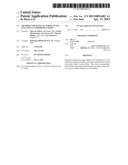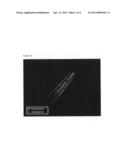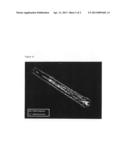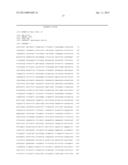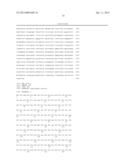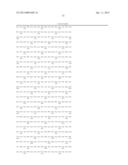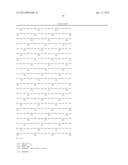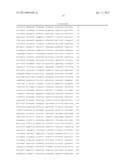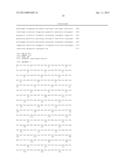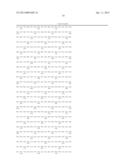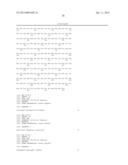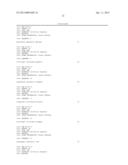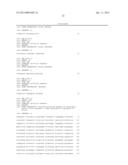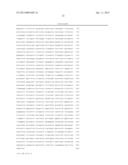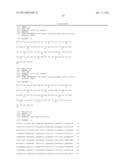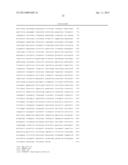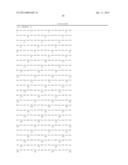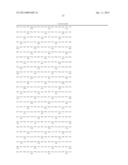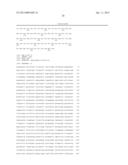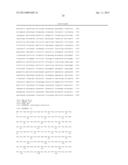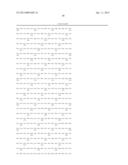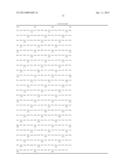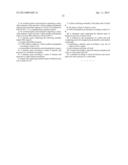Patent application title: METHODS FOR MANUFACTURING PLANT CELL WALLS COMPRISING CHITIN
Inventors:
Marc De Block (Merelbeke, BE)
Marc De Block (Merelbeke, BE)
Frank Meulewaeter (Merelbeke, BE)
Vincent Bulone (Taby, SE)
Gea Guerriero (Naples, IT)
Assignees:
Bayer CropScience N.V.
IPC8 Class: AC12N1582FI
USPC Class:
800284
Class name: Multicellular living organisms and unmodified parts thereof and related processes method of introducing a polynucleotide molecule into or rearrangement of genetic material within a plant or plant part the polynucleotide alters carbohydrate production in the plant
Publication date: 2013-04-11
Patent application number: 20130091602
Abstract:
Methods and means are provided for the modification of the reactivity of
plant secondary cell walls, particularly in cotton cell walls found in
cotton fibers. This can be conveniently achieved by expressing a chimeric
gene encoding a Saprolegnia monoica chitin synthase in cotton plants.Claims:
1. An isolated nucleic acid molecule comprising a nucleotide sequence
which encodes a chitin synthase polypeptide wherein said nucleotide
sequence is at least 97% identical to SEQ ID NO: 1 or a complementary
sequence thereof.
2. An isolated nucleic acid molecule comprising a nucleotide sequence which encodes a chitin synthase polypeptide which is at least 80% identical to SEQ ID NO: 2.
3. A chimeric gene comprising the following operably linked DNA regions: a) a plant-expressible promoter, b) a DNA region coding for a chitin synthase polypeptide according to claim 1 or 2, c) a transcription termination and polyadenylation region.
4. A chimeric gene according to claim 3 wherein said promoter is a constitutive promoter.
5. A chimeric gene according to claim 3 wherein said promoter is a fiber-selective promoter.
6. A plant cell comprising a chimeric gene as defined in any one of claims 3 to 5.
7. A plant consisting essentially of the plant cells of claim 6.
8. The plant of claim 7 which is cotton.
9. Fibers obtainable from the plant according to claim 7 or 8.
10. A transgenic seed comprising the chimeric gene as defined in any one of claims 3 to 5.
11. A method for the manufacture of a plant cell wall comprising positively charged polysaccharides, said method comprising a) expressing a chimeric gene according to any one of claim 3 or 5 in a plant, b) and isolating said plant cell wall.
12. A method according to claim 11 wherein said plant cell wall is a cotton plant cell wall.
13. A method according to claim 12 wherein said cotton plant cell wall is present in a cotton fiber.
Description:
FIELD OF THE INVENTION
[0001] The present invention relates to the modification of the reactivity of plant cell walls such as secondary plant cell walls. In particular, the present invention provides cotton fibers comprising positively charged polysaccharides such as chitin and chitosan. These cotton fibers have a modified reactivity which can be exploited for dyeing the fibers with fiber-reactive dyes. In addition, the modified reactivity can be applied to improve the reactivity of the fibers with reactants such as flame retardants, water, oil and soil repellents, softeners, antistatic agents, fluorescent whitening agents and the like.
INTRODUCTION TO THE INVENTION
[0002] Mankind has been using natural fibers, including cellulose containing natural fibers from plants, such as cotton and linen, for several thousand years to produce many different kinds of textiles. With increasing demand and improved fiber quality, a global textile industry based on cotton developed rapidly. Today, cotton contributes approximately 45 percent to the world's clothing, and many of the best fashion houses use textiles made from high quality cotton. Cotton fiber consists of cellulose, a natural polymer composed of many molecules of the sugar glucose. Its unique structure is ideally suited for textile production. Each fiber is basically a hollow tube a few centimetres in length that, when spun and woven, provides the very special characteristic "feel" of cotton. Natural cellulose containing fibers, however, do not possess the chemical versatility of synthetic fibers, due to the relative inert nature of the cellulose consisting of β-1-4 linked glucose monomers. This relatively inert nature is apparent during the dyeing process of cotton fibers and fabrics. Direct dyes and fiber-reactive dyes are two types of anionic dyes used to color cotton. Cotton itself develops an anionic charge in water, so that without special treatment, the uptake of dye by the fiber or fabric is quite elaborate. Direct dyes create a relatively weak hydrogen bond with the cellulose polymer forming a semi-permanent attachment because it does not withstand well washing. Fiber-reactive dyes are molecules that combine chromophores with a reactive group that forms strong covalent bonds with the fiber via reaction with hydroxyl groups. The covalent bonds provide a good resistance of the dyed fiber against laundring. During the dyeing process, large amounts of electrolytes are needed to shield the anionic dyes from the anionic fiber charges. Unreacted hydrolyzed dyes (up to 40%) need to be removed by a washing step, generating large volumes of wastewater, also containing the above mentioned electrolytes.
[0003] Providing the cellulose fiber with a positive electric charge, e.g. by incorporation of positively charged chemical compounds, could therefore improve the dyeability of natural cellulose fibers, as well as improve any chemical reaction of the modified cellulose fiber with negatively charged chemical compounds. It would also make the use of acidic dyes possible.
[0004] Several publications have described the coating of chitosan oligomers onto cellulose fibers to make chitosan/cellulose blends, yarns or fabrics. Chitosan is a positively charged polymer of glucosamine, which can be obtained by deacetylation of chitin, e.g. by alkaline treatments. Chitin itself is a polymer of β-1-4 linked N-acetylglucosamine (GlcNAc).
[0005] Liu et al. (Carbohydrate Polymers 44(2003) 233-238) described a chemical method for surface coating cotton fibers with chitosan. With this chitosan coating, the cotton fiber surface became physiologically and biologically active because of the chemical reactivity of the amino group leading to a higher potential for subsequent chemical modification of the fibers. Based on the physiological function of chitosan in inhibiting e.g. dermatophytes, many functional clothes, fabrics and fibers employ cellulose-chitosan blend fibers, cellulose fiber-chitosan conjugate and fabrics coated with chitosan-containing resins.
[0006] WO 00/09729 describes the expression of chitin synthase and chitin deacetylase genes in plants to alter the cell wall for industrial uses and improved disease resistance. Specifically cited uses are: to provide a single plant source of cellulose, chitin and chitosan, to increase tensile strength and to increase brittle snap. Specifically suggested chitin synthase genes are derived from fungal organisms. Experimental data are neither provided on the production of chitin or chitosan in plants, nor on the incorporation thereof in plant cell walls. WO2006/136351 showed that the strategy as proposed in WO00/09729 does not lead to the functional incorporation of chitin into the plant cell wall. Instead WO 2006/136351 discloses that chitin is effectively produced in the secondary cell wall of cotton fibers only when the fungal chitin synthase (from Neurospora crassa) is actively relocated to the Golgi apparatus. The latter is achieved by operable fusion of this fungal chitin synthase with a signal anchor sequence specific for the Golgi apparatus, and by expressing the resulting chimeric gene in plants. Although, chitin could be efficiently produced in cotton plant cell walls it was also observed that the transgenic plants remained smaller presumably due to toxicity of the expression of the chimeric chitin synthase in cotton outside of the cotton fibers.
[0007] Thus there remains a need for alternative methods to produce plant cell walls such as secondary cell walls which comprise positively charged polysaccharides. In particular a need exists for providing methods to produce fibers which can be directly harvested from plants and which contain positively charged chemical groups and/or group which are more reactive than hydroxyl groups of cellulose, which can be used directly without the need for further chemical treatment to introduce such chemical groups and wherein the transgenic plants do not show a growth retardation. These and other problems are solved as described hereinafter in the different embodiments, examples and claims.
SUMMARY OF THE INVENTION
[0008] The invention shows that the expression of a chitin synthase derived from Saprolegnia monoica, which is not operably linked with a Golgi targeting signal, in plant cells leads to the efficient incorporation of N-acetylglucosamine polymers in the plant cell wall, in particular the plant secondary cell wall. The invention described herein in the different embodiments, examples, and claims provides Saprolegnia chitin synthases and chimeric genes thereof comprised in expression cassettes which can be used to modify the plant cell walls with positively charged polysaccharides. Accordingly, the invention provides in a first object an isolated nucleic acid molecule comprising a nucleotide sequence which encodes a chitin synthase polypeptide wherein said nucleotide sequence is at least 97% identical to SEQ ID NO: 1 or a complementary sequence thereof. In another embodiment the invention provides an isolated nucleic acid molecule comprising a nucleotide sequence which encodes a chitin synthase polypeptide which is at least 80% identical to SEQ ID NO: 2. In yet another embodiment the invention provides a chimeric gene comprising the following operably linked DNA regions a) a plant-expressible promoter, b) a nucleotide sequence which is at least 97% identical to SEQ ID NO: 1 or a complementary sequence thereof or a nucleotide sequence which encodes a chitin synthase polypeptide which is at least 80% identical to SEQ ID NO: 2 and c) a transcription termination and polyadenylation region. In yet another embodiment the chimeric gene comprises a constitutive promoter. In yet another embodiment the chimeric gene comprises a fiber-selective promoter. In yet another embodiment the chimeric gene comprises an expansin promoter. In yet another embodiment the invention provides a chimeric gene as defined in any of the previous embodiments. In yet another embodiment the invention provides a plant consisting essentially of a plant cell comprising a chimeric gene as defined in any of the previous embodiments. In a particular embodiment the plant is a cotton plant. In yet another embodiment the invention provides fibers obtained from the plant according to the invention. In yet another embodiment the invention provides a transgenic seed comprising a chimeric gene as defined in any of the previous embodiments. In yet another embodiment the invention provides a method for the manufacture of a plant cell wall comprising positively charged polysaccharides, said method comprises expressing a chimeric gene according to any of the previous embodiments in a plant and isolating said plant cell wall. In a particular embodiment said method provides a cotton plant cell wall. In yet another particular embodiment said method provides a cotton plant cell wall which is present in a cotton fiber.
FIGURE
[0009] FIG. 1:
[0010] FIG. 1a shows untransformed mature trichomes (Arabidopsis thaliana) which are stained with a rhodamine-conjugated chitin-binding probe while FIG. 1b shows recombinant mature trichomes (Arabidopsis thaliana) comprising the SmCHS2 chimeric gene stained with a rhodamine-conjugated chitin-binding probe. A clear reaction with the chitin binding probe is observed since the recombinant trichomes (FIG. 1b) are stained more intensively than trichomes derived from control plants (FIG. 1a). Chitin is witnessed by the presence of red dots in the recombinant trichomes (FIG. 1b) while the red dots are absent in the untransformed trichomes (FIG. 1a).
DETAILED DESCRIPTION OF DIFFERENT EMBODIMENTS OF THE INVENTIONS
[0011] The current invention hinges on the remarkable finding that expression of the Saprolegnia monoica gene coding for a chitin synthase in plant cells leads to the efficient incorporation of N-acetylglucosamine (GlcNAc) polymers into plant cell walls. The Saprolegnia monoica gene coding for a chitin synthase does not require to be operably linked (or fused) with a Golgi targeting localisation signal as was required with the Neurospora crassa chitin synthase in WO2006/136351. In the present invention it was observed that chitin (i.e. a polymer of N-acetylglucosamine) was made in the cell wall, in particular the secondary cell wall, of the transgenic plants. The Saprolegnia monoica gene coding for a chitin synthase can be used e. g. for expression in cotton plants for the generation of more reactive cotton fibers.
[0012] Thus the invention provides in a first embodiment an isolated nucleic acid molecule comprising a nucleotide sequence which encodes a chitin synthase polypeptide wherein said nucleotide sequence is at least 97% identical to SEQ ID NO: 1 or a complementary sequence thereof. SEQ ID NO: 1 depicts the nucleotide sequence of the Saprolegnia monoica chitin synthase 2 (SmCHS2).
[0013] In another embodiment the invention provides an isolated nucleic acid molecule comprising a nucleotide sequence which encodes a chitin synthase polypeptide which is at least 80% identical to SEQ ID NO: 2. SEQ ID NO: 2 depicts the amino acid sequence of the Saprolegnia monoica chitin synthase 2 (SmCHS2). In a specific embodiment the invention provides an isolated nucleic acid molecule comprising a nucleotide sequence which encodes a chitin synthase polypeptide which is at least 85%, at least 90%, at least 95% or at least 98% or even at least 99% identical to SEQ ID NO: 2. In yet another embodiment the invention provides an isolated nucleic acid molecule comprising a nucleotide sequence which encodes a chitin synthase polypeptide wherein said nucleotide sequence is at least 90% identical to SEQ ID NO: 3 or a complementary sequence thereof. In a specific embodiment the invention provides an isolated nucleic acid molecule comprising a nucleotide sequence which encodes a chitin synthase polypeptide wherein said nucleotide sequence is at least 95%, at least 98 or even at least 99% identical to SEQ ID NO: 3 or a complementary sequence thereof. SEQ ID NO: 3 is the Saprolegnia monoica chitin synthase 1 (SmCHS1). In yet another embodiment the invention provides an isolated nucleic acid molecule comprising a nucleotide sequence which encodes a chitin synthase polypeptide which is at least 80% identical to SEQ ID NO: 4. In a specific embodiment the invention provides an isolated nucleic acid molecule comprising a nucleotide sequence which encodes a chitin synthase polypeptide which is at least 85%, at least 90% identical, at least 95%, at least 98% or even at least 99% identical to SEQ ID NO: 4. SEQ ID NO: 4 is the amino acid sequence of the Saprolegnia monoica chitin synthase 1.
[0014] Nucleic acids can be DNA or RNA, single- or double-stranded. Nucleic acids can be synthesized chemically or produced by biological expression in vitro or even in vivo. Nucleic acids can be chemically synthesized using appropriately protected ribonucleoside phosphoramidites and a conventional DNA/RNA synthesizer. Suppliers of RNA synthesis reagents are Proligo (Hamburg, Germany), Dharmacon Research (Lafayette, Colo., USA), Pierce Chemical (part of Perbio Science, Rockford, Ill., USA), Glen Research (Sterling, Va., USA), ChemGenes (Ashland, Mass., USA), and Cruachem (Glasgow, UK).
[0015] In connection with the chimeric gene of the present disclosure, DNA includes cDNA and genomic DNA.
[0016] In enzymology, a chitin synthase (EC 2.4.1.16) is an enzyme that catalyzes the chemical reaction:
[0017] UDP-N-acetyl-D-glucosamine+[1,4-(N-acetyl-beta-D-glucosaminyl)]n.fw- darw.UDP+[1,4-(N-acetyl-beta-D-glucosaminyl)]n+1
[0018] Thus, the two substrates of this enzyme are UDP-N-acetyl-D-glucosamine and [[[1,4-(N-acetyl-beta-D-glucosaminyl)]n]], whereas its two products are UDP and [[[1,4-(N-acetyl-beta-D-glucosaminyl)]n+1]]. This enzyme belongs to the family of glycosyltransferases, specifically the hexosyltransferases. The systematic name of this enzyme class is UDP-N-acetyl-D-glucosamine:chitin 4-beta-N-acetylglucosaminyl-transferase. Other names in common use include chitin-UDP N-acetylglucosaminyltransferase, chitin-uridine diphosphate acetylglucosaminyltransferase, chitin synthetase, chitin synthase and trans-N-acetylglucosaminosylase. This enzyme participates in aminosugars metabolism. Thus chitin is a polymer of beta-1,4-linked N-acetyl-D-glucosamine (GlcNAc)
[0019] The chitin synthases 1 and 2 (respectively depicted in SEQ ID NO: 3 and 1) are derived from Saprolegnia monoica. The genus Saprolegnia belongs to the family of Oomycetes. Based on their general morphology and lifestyles, this group was traditionally classified as fungi. However, a cladistic classification based on modern insights, supports a relatively close relationship with the photosynthetic organisms such as brown algae and diatoms, within the eukaryotic group--the heterokonts. The sequences of the chitin synthases 1 and 2 derived from S. monoica comprise a conserved aminoterminal domain of approximately 70 amino acids, also known as a MIT domain. A MIT domain is a conserved domain comprising approximately 70 amino acids, with alternating conserved hydrophobic and polar areas and a predicted helical secondary structure first identified in proteins involved in microtubule binding and in intracellular transport. Such a domain is designated as a MIT domain (contained within Microtubule Interacting and Trafficking molecules). The MIT domain is also found in sorting nexins, the nuclear thiol protease PalBH, the AAA protein spastin and archaebacterial proteins with similar domain architecture, vacuolar sorting proteins and others. The precise molecular function of the MIT domain is unclear. Without intending to limit the invention to a particular mode of action, it is thought that the MIT domain present in the chitin synthases of S. monoica is responsible for the efficient synthesis of chitin in the cell walls of transgenic plants. It was previously shown in WO2006/136351 that chitin synthases of fungal origin (such as a Neurospora crassa chitin synthase) had to be adapted by means of operable coupling of the fungal chitin synthase with a Golgi localisation signal, to obtain for efficient synthesis of chitin in the cell wall of transgenic plants. Since a MIT domain is present in a few other chitin synthases, in particular in some chitin synthases derived from oomycetes, the invention provides the use of chitin synthases naturally comprising an MIT domain for the manufacture of chitin in the plant secondary cell wall. Such chitin synthases naturally comprising an MIT domain include those of Saprolegnia parasitica having the amino acid sequence depicted in SEQ ID NO: 22 and SEQ ID NO: 24 or encoded by the nucleic acid sequences depicted in SEQ ID NO: 21 and SEQ ID NO: 23.
[0020] In another embodiment the invention provides the operable coupling of a MIT domain with a chitin synthase, such as a fungal chitin synthase, not comprising an MIT domain, e. g. a non-oomycete chitin synthase to generate a chimeric chitin synthase for efficient production of chitin in the plant secondary cell wall. In other words, disclosed is a chimeric gene comprising a DNA region coding for a chitin synthase polypeptide not comprising an MIT domain operably linked to a DNA region encoding an MIT domain such that, upon expression, a fusion protein is made, a plant expressible promoter and a transcription termination and polyadenylation region. Also disclosed is a method for the manufacture of a plant cell wall comprising positively charged polysaccharides comprising a) expressing a chimeric gene comprising a DNA region coding for a chitin synthase polypeptide not comprising an MIT domain operably linked to a DNA region encoding an MIT domain such that, upon expression, a fusion protein is made, a plant expressible promoter and a transcription termination and polyadenylation region; and b) isolating the plant cell wall obtained in a).
[0021] MIT domains have been assigned the Pfam family number PF04212. Currently, 495 proteins are known which are known or predicted to comprise an MIT domain. The sequences of these proteins can be retrieved e. g. from the UniProt server (http://www.uniprot.org/) under the following UniProt accession numbers which are followed by the position of the (predicted) MIT domain within the sequence. All sequences and in particular that of the (predicted) MIT domains are incorporated by reference in their entirety:
[0022] C5L7B3/6-74; C5K7I8/6-74; B9PJ69/9-77; B6K9M2/9-77; B9QA65/9-77; A7ASR9/7-74; B6AJD9/4-72; Q5CFS7/1-69; Q5CSB4/3-71; Q4UC87/4-82; B3L9J0/6-74; A5K3I1/6-74; Q8IKQ5/6-74; Q4Z291/6-74; Q4X5E3/6-74; Q7RRP6/6-74; A8IAJ1/7-74; Q6ETH5/5-73; B8AI60/5-73; B9SG62/5-73; B9HVY7/5-73; B9HL02/5-73; B9NGD1/5-73; Q3EDG2/1-41; Q9SGD4/1-41; Q8LKV4/5-73; B6TLN7/5-73; B8A2I4/5-73; B6T3Y2/5-73; A2WKH8/5-73; A2ZP36/5-73; B8A2W9/5-73; A2WKI0/5-73; Q5ZEN9/5-73; Q8LAK9/5-73; Q9ZNT0/5-73; Q9SEA8/5-73; Q1W2L1/5-73; B9HQW8/5-73; B9H1R8/5-73; A5BIG1/5-73; A7R0D5/5-73; A9SGM2/5-73; A9TBU2/5-73; A9P2N1/5-73; B9SCR4/5-73; A4S3E8/8-75; C1ECR7/11-78; C1NA06/11-78; C1E2F1/103-169; B6K5C2/6-74; Q09803/6-74; A8PSV3/1-33; Q5KC30/6-74; Q4PDZ4/6-74; A8N0F3/6-74; B0DXQ0/6-74; A7F3H9/6-74; Q7S0H4/6-74; Q2GQ74/6-74; B2AFE6/6-74; C5FLK6/6-74; C5JDP2/6-74; C5GXE6/6-74; C0NGS1/6-74; C0SHS5/6-74; C1H9G7/6-74; C1GCX1/6-74; C4JW95/6-74; Q1E6C4/6-74; B6QQZ4/6-74; B8M727/6-74; Q2UQD2/6-74; B8MZP8/6-74; A1D7B7/7-75; B0XY62/7-75; Q4WXF8/7-75; Q5B8R9/6-74; Q0CXN9/6-74; B6GYF9/6-74; A2R7C1/6-74; A1CK47/6-74; B2VXZ4/6-65; Q0U7R6/6-74; Q6CEE2/6-74; Q5YKJ0/7-75; C4R134/4-72; Q6FQG5/6-74; Q9C1F4/6-74; B3LKD3/6-74; A6ZX48/6-74; P52917/6-74; B5VTV5/1-34; C5DUT4/6-74; Q6CVM8/6-74; C5DBA6/6-74; A7TH89/6-74; Q758U9/6-74; C4Y9U8/7-75; Q5AGH7/7-75; Q5AG40/7-75; B9WHM5/7-75; A5E2L0/55-123; C5MHK4/5-73; A5DQ68/6-74; A3LVF1/7-75; Q6BPY2/7-75; A9V5Z2/5-73; Q57V58/5-74; Q4E658/5-74; Q4D9C2/5-74; Q4FXF2/5-74; A4I4W4/5-74; A4HHP9/5-74; Q54PT2/6-74; Q4RKZ3/1-69; A8QBQ7/7-76; C3YEH0/5-74; C3ZYE4/31-98; C4Q408/2-71; Q5DBH6/2-71; A8Y1H3/5-74; Q9BL83/5-74; B3RJ28/5-74; A7SK75/5-74; B3MXW2/6-75; Q29H77/6-75; B4NPI4/6-75; B4L2B2/6-75; B3NWZ3/6-75; B4M6S6/6-75; B4R6Q7/6-75; B4I6L5/6-75; Q9Y162/6-75; B4Q2M1/6-75; Q7QFR0/6-75; B0XJH8/6-75; Q17GP3/6-75; B7PVD7/6-75; Q66IY7/5-74; B2GUK1/3-72; B2RCB7/5-74; Q9UN37/5-74; Q08BZ6/5-74; Q4SKA0/1-69Q2HJB1/5-74; Q793F9/5-74; Q8VEJ9/5-74; Q6IRG3/5-74; Q3TDX2/5-74; Q5U4Y4/7-76; Q6DJK7/7-76; Q8AVB9/7-76; B5X7N1/5-74; VPS4B/7-76; A8K4G7/7-76; Q69HW4/7-76; A8K5D8/7-76; O75351/7-76; Q3TN07/7-76; Q6PJZ4/7-76; P46467/7-76; Q4KLL7/7-76; Q3U8P5/7-76; Q0VD48/7-76; Q4RVG5/6-75; Q5ZMI9/4-73; C0H991/95-164; B5X1U4/6-75; Q7SXY0/6-75; A7YYH5/6-75; B2GU12/6-75; A5WWM0/6-75; C0H991/9-78; Q8T127/7-75; B7P0K9/283-324; C3Z907/321-389; A7S4I8/283-324; Q4S8A8/285-352; A4IG43/277-345; A4IID6/279-347; Q4V7Q6/279-347; Q5ZJH6/280-348; B4DFS6/190-258; B4DRQ7/280-348; B2RXK3/280-348; B4DDG2/163-231; B4DQN3/163-231; B4DFT0/291-359; Q3U3Q1/280-348; B2RXB9/280-348; B3RSI2/276-344; B4GNS6/275-343; Q29BD1/275-343; B4NAJ4/275-343; B3M073/275-343; Q86P98/275-343; Q8T0L6/275-343; Q9VHF6/275-343; B3P1R41275-343; B4QX75/275-343; B4HKF5/275-343; B4PUL9/275-343; B4K4Y3/275-343; B4LW06/275-343; B4JYT0/275-343; B0XAE0/178-246; Q7QEQ2/275-343; Q5C1I1/163-221; C4Q8U0/273-338; B0E7C2/4-72; C4LYN8/4-72; A3DP09/6-74; B8D2W2/9-77; A9A4K6/8-76; B3TCM2/8-75; A0RVT9/8-75; Q877H3/7-75; Q972B3/7-75; Q97ZJ7/7-75; C3MPU4/7-75; C3NE34/7-75; C3NHM9/7-75; C4KH36/7-75; C3MUV6/7-75; C3N5H0/7-75; A4YHC5/7-75; A2BKZ1/9-75; Q9YDF3/7-75; C4LZH7/3-71; A8BSU6/8-77; Q8T6L4/8-77; B8C9Z5/5-73; B8LDI1/5-73; B7GCY6/5-73; Q54CX7/4-72; Q22143/5-70; A8XST3/5-70; Q54CX7/246-316; Q55GN8/5-73; A4QZC1/8-77; A2D8M 7/10-80; Q54RJ5/10-79; C4LYH7/2-70; Q8I8X1/16-84; Q54CX7/120-188; Q0UZT0/375-444; C4JEZ5/18-85; Q1E904/19-86; C5FCB8/23-90; C1GDJ4/63-130; C0SAK1/19-86; C1HDA2/19-86; C5JPG7/78-145; C5G855/19-86; A6RHR0/1-68; C0NMG2/1-68; A2QKF2/239-307; B6H2K6/100-168; Q0CFY4/216-284; B0XW44/210-278; A1DG63/193-261; Q4X270/211-279; A1CSH7/266-334; B8NC13/82-150; Q2TZ95/233-301; Q5B0X3/178-246; B8M0Z2/44-113; B6Q8T3/44-113; A7EZ31/1-69; A6S2Q3/293-361; Q7S0P7/402-470; B2ADU1/368-424; Q2GTY0/352-420; C1E4H7/3-68; C1MPZ7/3-69; C3ZZL4/6-70; B7P5B6/8-73; Q9R1S8/6-71; Q499T5/6-71; Q9Y6W3/6-71; B2RAM2/6-71; Q7Z479/6-71; A0FKG7/6-71; B0FGU2/6-71; B4F6P1/6-71; C0H9M1/6-71; Q4S467/6-71; B3RQK1/8-73; A7RRP7/7-70; Q54JG4/13-81; Q55GN8/176-244; C4LYH7/369-438; Q8I8X1/383-452; B0EV39/371-440; A9V3C1/6-74; A7URZ9/6-72; B0X0P8/1-69; Q16FL8/1-69; Q0IFG1/1-69; B4KNS6/15-76; B4MS07/21-82; B3M8E0/5-71; B4IZ41/4-72; B4KXT1/5-71; B4MFW3/3-71; B4MLA7/3-71; Q29EY7/4-71; B3NG09/3-71; B4PH91/3-71; Q9VZK1/3-71; Q7YU93/3-71; B4QQ18/3-62; B4HTX3/3-71; B3RKL7/450-515; Q7T332/322-390; A9JT54/322-390; A4IIB7/268-336; Q28CB9/261-329; Q63ZH0/269-337; Q0P3R2/270-338; A7SVK8/274-341; Q20821/252-320; A8Y3X4/266-339; Q148E7/275-343; B3KU31/268-336; B2RDR2/268-336; Q9NRS6/268-336; B0CM75/268-336; Q4V896/269-337; Q91WE1/268-336; Q9CW22/63-131; Q6NU31/257-325; KS6C1/239-307; B1APS8/227-295; B3KVM4/239-307; B4DRK0/58-126; Q5R5U6/239-307; KS6C1/238-306; B8JLT3/232-300; Q4RR16/253-353; B4N G93/233-301; B3MTR0/236-304; B3NZ90/246-314; Q9VEA9/242-310; B4QUH5/242-310; B4IB83/242-310; B4PL88/246-314; B4GLM4/255-323; Q293U2/255-323; B4JI50/203-271; B4K7H6/227-295; B4M0W2/211-279; Q7PYF1/252-320; B0X4C2/216-284; Q16ZH6/224-292; Q4RLU8/6-73; Q8R2S1/49-117; B4DSP6/49-117; Q5RA67/49-117; Q9Y6S9/49-117; Q32PG2/49-117; A9RII8/29-104; B8B1Z6/49-124; Q658G8/49-124; B4FVB5/49-124; Q944N4/90-165; A8MRR2/55-130; Q0WMJ4/55-130; O64630/55-130; B9RDF4/52-127; B9IC21/13-88; A7PY13/56-131; A5BB69/56-131; A5BIC4/76-120; A9V1R3/29-100; B3S0V7/15-93; C3XZ15/1-79; C3ZJS8/19-88; B7PXE3/98-174; B4NBP4/237-313; B4M0H8/223-299; B4K799/217-293; B4JII0/234-310; B4G437/239-315; B4QSF0/232-308; B3M301/235-311; B4HGG6/232-308; B3P8A3/232-308; Q298L4/239-315; B4PL32/232-308; Q8I0P1/232-308; Q16IA7/179-255; Q7QBW0/230-306; B0X289/2-60; Q4TCF6/6-91; Q4TCD9/16-91; Q6NW58/83-158; Q6AZT2/110-185; Q05AS3/113-188; Q9QYY8/117-193; Q9UBP0/119-195; A2VDN5/117-193; Q719N 1/116-192; Q5ZK92/116-192; B2RYN7/117-192; C3XW83/29-96; B7Q7T2/7-83; A7RQX2/15-88; Q4RRG4/9-85; C0H9Y4/20-96; Q0P3W0/20-96; Q4SG05/11-87; A8WFZ3/15-90; B3DLA2/21-97; Q8R1X6/19-95; Q3TVW1/19-95; A0JNJ3/19-95; Q4R7V2/19-95; Q8N0X7/19-95; B3KMI3/19-95; A8K6Q9/19-95; A2Q8K6/7-77; Q00204/6-77; B8MY71/5-77; Q9Y6Z8/5-77; Q0CUT6/6-77; A1CRW2/6-77; Q1DXZ5/5-72; B6QNP8/12-76; B0DXY2/11-78; Q7QGN5/7-67; B0WDD1/4-67; Q179Z1/4-67; Q179Z0/4-67; B7P5B6/89-157; Q5DBL1/86-142; A8P1B5/37-127; Q9R1S8/86-154; Q7Z479/86-154; B2RAM2/86-154; Q9Y6W3/86-154; A0FKG7/86-154; B0FG U2/86-154; Q499T5/86-154; C0H9M1/86-154; B4F6P1/86-154;Q4S467/86-149;Q6NVT4/42-110; C1BMZ4/11-74;A8PMC5/4-73; Q5D999/6-77; Q5D9R4/6-77; C4Q8N9/35-106; A7RL55/2-70; Q5I0J5/12-79; Q8VDV8/12-79; Q8WV92/12-79; B8ZZL5/12-79; A8YXZ4/12-79; Q6DJ62/7-75; C3XWE6/1-69; B0S8J9/9-77; B5XBB0/7-75; Q4S0N8/9-77; Q54KQ7/168-232; B3RXW5/5-72; A8PZJ1/282-350; C3Z907/423-490; Q4V7Q6/374-442; Q3U3Q1/375-444; B2RXB9/375-444; B4DFT0/386-455; B4DRQ7/375-444; B4DDG2/258-327; B4DFS6/285-354; B4DQN3/258-327; B2RXK3/375-444; A41G43/372-441; Q5ZJH6/375-444; Q7QEQ2/417-485; B0XAE0/287-363; B3M073/404-479; B4HKF5/399-474; B3P1R4/399-474; B4PUL9/399-474; B4QX75/399-474; B4JYT0/404-479; Q86P98/399-474; Q9VHF6/399-474; Q8T0L6/399-464; Q29BD1/399-474; B4NAJ4/403-478; B4LW06/400-475; B4K4Y3/397-472. Further MIT domains include those disclosed in Ciccarelli et al. (2003; Genomics 81: 437-41) or Patel et al. (2002; Nature Genetics 31: 347-8) or in the pdb (protein data bank) files (or related publications): 1wfd (Suetake et al.; Solution structure of mouse MIT domain); 1wr0 (Takasu et al. (2005). Biochem Biophys Res Commun, 334, 460-465.), 1yxr (Scott et al. (2005) Proc Natl Acad Sci USA. 102:13813-13818), 2cpt (Suetake et al.; Solution structure of MIT domain from human skd1), 2dI1 (Suetake et al.; Solution structure of MIT domain from human spartin), 2jq9 and 2jqh (Stuchell-Brereton et al. (2007). Nature, 449, 740-744.), 2k3w (C. Kieffer et al. (2008). Dev Cell, 15, 62-73.), 2v6x, 2v6y (T. Obita et al. (2007). Nature, 449, 735-739.), 2w2u (Samson et al. (2008). Science, 322, 1710-1713.), 2zam, 2zan, 2zao (all Inoue et al. (2008). Traffic, 9, 2180-2189.) or 3eab (Yang et al. (2008). Nat Struct Biol, 15, 1278-1286.).
[0023] In the chitin synthases identified herein, the MIT domain is located in an amino acid stretch from position 103 to 171 in SEQ ID NO: 4 (CHS1), corresponding to SEQ ID NO: 19, and from position 141 to 209 in SEQ ID NO: 2 (CHS2), corresponding to SEQ ID NO: 20.
[0024] Further example MIT domains show at least 80%, at least 85%, at least 90%, at least 95%, at least 98%, at least 99% or even 100% sequence identity to the MIT domains present in CHS1 (SEQ ID NO: 4), corresponding to SEQ ID NO: 20, and CHS2 (SEQ ID NO: 2), corresponding to SEQ ID NO: 19, or any one of the MIT domains present in the UniProt sequences or in the references listed above. All MIT domains disclosed herein have the biological function of the MIT domains present in CHS1 (SEQ ID NO: 4) and CHS2 (SEQ ID NO: 2). Said biological function can e. g. be evaluated by checking the location of a fusion protein comprising said MIT domain in a plant cell as outlined in the examples.
[0025] As used herein, the term "% sequence identity" refers to the percentage of identical nucleotides between two segments of a window of optimally aligned DNA. Optimal alignment of sequences for aligning a comparison window are well-known to those skilled in the art and may be conducted by tools such as the local homology algorithm of Smith and Waterman (Waterman, M. S., Chapman & Hall. London, 1995), the homology alignment algorithm of Needleman and Wunsch (1970), the search for similarity method of Pearson and Lipman (1988), and preferably by computerized implementations of these algorithms such as GAP, BESTFIT, FASTA, and TFASTA available as part of the GCG (Registered Trade Mark), Wisconsin Package (Registered Trade Mark from Accelrys Inc., San Diego, Calif.). An "identity fraction" for aligned segments of a test sequence and a reference sequence is the number of identical components that are shared by the two aligned sequences divided by the total number of components in the reference sequence segment, i.e., the entire reference sequence or a smaller defined part of the reference sequence. Percent sequence identity is represented as the identity fraction times 100. The comparison of one or more DNA sequences may be to a full-length DNA sequence or a portion thereof, or to a longer DNA sequence.
[0026] An MIT domain may e. g. be operably linked with any of the following chitin synthases (Chitin UDP-acetyl-glucosaminyl transferases) which can be found in the different databases including amino acid sequences with the following identifiers (accession numbers): CHS1_AJECA (P30576) Chitin synthase 1 (EC 2.4.1.16) (Chitin-UDP acetyl-glucosaminyl transferase 1) (Class-I chitin synthase 1) from Ajellomyces capsulata (Histoplasma capsulatum); CHS1_AJEDE (P30579) Chitin synthase 1 (EC 2.4.1.16) (Chitin-UDP acetyl-glucosaminyl transferase 1) (Class-I chitin synthase 1) from Ajellomyces dermatitidis (Blastomyces dermatitidis); CHS1_ASPNG (P30581) Chitin synthase 1 (EC 2.4.1.16) (Chitin-UDP acetyl-glucosaminyl transferase 1) (Class-I chitin synthase 1) from Aspergillus niger; CHS1_BOTCI (P49603) Chitin synthase 1 (EC 2.4.1.16) (Chitin-UDP acetyl-glucosaminyl transferase 1) (Class-I chitin synthase 1) from Botrytis cinerea (Noble rot fungus) (Botryotinia fuckeliana); CHS1_CANAL (P23316) Chitin synthase 1 (EC 2.4.1.16) (Chitin-UDP acetyl-glucosaminyl transferase 1). from Candida albicans (Yeast); CHS1_CRYNV (O13356) Chitin synthase 1 (EC 2.4.1.16) (Chitin-UDP acetyl-glucosaminyl transferase 1) (Class-IV chitin synthase 1). {GENE: Name=CHS1}--Cryptococcus neoformans var. grubii (Filobasidiella neoformans var. grubii); CHS1_EMENI (P30583) Chitin synthase 1 (EC 2.4.1.16) (Chitin-UDP acetyl-glucosaminyl transferase 1) (Class-I chitin synthase 1) (Fragment). {GENE: Name=chs1}--Emericella nidulans (Aspergillus nidulans); CHS1_EXODE (P30600) Chitin synthase 1 (EC 2.4.1.16) (Chitin-UDP acetyl-glucosaminyl transferase 1) (Class-II chitin synthase 1). {GENE: Name=CHS1}--Exophiala dermatitidis (Wangiella dermatitidis); CHS1_EXOJE (P30585) Chitin synthase 1 (EC 2.4.1.16) (Chitin-UDP acetyl-glucosaminyl transferase 1) (Class-I chitin synthase 1) (Fragment). {GENE: Name=CHS1}--Exophiala jeanselmei; CHS1_NEUCR (P29070) Chitin synthase 1 (EC 2.4.1.16) (Chitin-UDP acetyl-glucosaminyl transferase 1) (Class-III chitin synthase 3). {GENE: Name=chs-1; ORFNames=B11H24.170, NCU03611.1}--Neurospora crassa; CHS1_PHAEX (P30590); Chitin synthase 1 (EC 2.4.1.16) (Chitin-UDP acetyl-glucosaminyl transferase 1) (Fragment). {GENE: Name=CHS1}--Phaeococcomyces exophialae; CHS1_PHYBL (P87073) Chitin synthase 1 (EC 2.4.1.16) (Chitin-UDP acetyl-glucosaminyl transferase 1) (Class-II chitin synthase 1). {GENE: Name=chs1}--Phycomyces blakesleeanus; CHS1_RHIAT (P30592) Chitin synthase 1 (EC 2.4.1.16) (Chitin-UDP acetyl-gfucosaminyl transferase 1) (Class-I chitin synthase 1) (Fragment). {GENE: Name=CHS1}--Rhinocladiella atrovirens; CHS1_RHIOL (P30594) Chitin synthase 1 (EC 2.4.1.16) (Chitin-UDP acetyl-glucosaminyl transferase 1). {GENE: Name=CHS1}--Rhizopus oligosporus; CHS1_RHIRA (Q12632) Chitin synthase 1 (EC 2.4.1.16) (Chitin-UDP acetyl-glucosaminyl transferase 1) (Class-II chitin synthase 1). {GENE: Name=CHS1}--Rhizomucor racemosus (Mucor circinelloides f. lusitanicus); CHS1_SCHCO (P30596); Chitin synthase 1 (EC 2.4.1.16) (Chitin-UDP acetyl-glucosaminyl transferase 1) (Fragment). {GENE: Name=CHS1}--Schizophyllum commune (Bracket fungus); CHS1_SCHPO (P30597) Chitin synthase 1 (EC 2.4.1.16) (Chitin-UDP acetyl-glucosaminyl transferase 1). {GENE: Name=chs1; ORFNames=SPAC13G6.12c, SPAC24B11.01c}--Schizosaccharomyces pombe (Fission yeast); CHS1_TUBUN (P55003) Chitin synthase 1 (EC 2.4.1.16) (Chitin-UDP acetyl-glucosaminyl transferase 1) (Fragment). {GENE: Name=CHS1}--Tuber uncinatum (Burgundy truffle); CHS1_USTMA (P30598) Chitin synthase 1 (EC 2.4.1.16) (Chitin-UDP acetyl-glucosaminyl transferase 1) (Fragment). {GENE: Name=CHS1}--Ustilago maydis (Smut fungus); CHS1_XYLBA (P30603) Chitin synthase 1 (EC 2.4.1.16) (Chitin-UDP acetyl-glucosaminyl transferase 1) (Fragment). {GENE: Name=CHS1}--Xylohypha bantiana; CHS1_YEAST (P08004) Chitin synthase 1 (EC 2.4.1.16) (Chitin-UDP acetyl-glucosaminyl transferase 1). {GENE: Name=CHS1; Saccharomyces cerevisiae (Baker's yeast); CHS2_AJECA (P30577) Chitin synthase 2 (EC 2.4.1.16) (Chitin-UDP acetyl-glucosaminyl transferase 2) (Class-III chitin synthase 2) Ajellomyces capsulata (Histoplasma capsulatum); CHS2_AJEDE (P30580) Chitin synthase 2 (EC 2.4.1.16) (Chitin-UDP acetyl-glucosaminyl transferase 2) (Class-II chitin synthase 2) {GENE: Name=CHS2}--Ajellomyces dermatitidis (Blastomyces dermatitidis) CHS2_ASPNG (P30582); Chitin synthase 2 (EC 2.4.1.16) (Chitin-UDP acetyl-glucosaminyl transferase 2) (Class-II chitin synthase 2) (Fragment). {GENE: Name=chs2}--Aspergillus niger; CHS2_CANAL (P30572) Chitin synthase 2 (EC 2.4.1.16) (Chitin-UDP acetyl-glucosaminyl transferase 2). {GENE: Name=CHS2}--Candida albicans (Yeast); CHS2_EXODE (P30601) Chitin synthase 2 (EC 2.4.1.16) (Chitin-UDP acetyl-glucosaminyl transferase 2) (Class-I chitin synthase 2). {GENE: Name=CHS2}--Exophiala dermatitidis (Wangiella dermatitidis); CHS2_EXOJE (P30586) Chitin synthase 2 (EC 2.4.1.16) (Chitin-UDP acetyl-glucosaminyl transferase 2) (Fragment). {GENE: Name=CHS2}--Exophiala jeanselmei; CHS2_NEUCR (P30589); Chitin synthase 2 (EC 2.4.1.16) (Chitin-UDP acetyl-glucosaminyl transferase 2). {GENE: Name=chs-2; ORFNames=NCU05239.1}--Neurospora crassa; CHS2_PARBR (Q92444) Chitin synthase 2 (EC 2.4.1.16) (Chitin-UDP acetyl-glucosaminyl transferase 2) (Class-II chitin synthase 2). {GENE: Name=CHS2}--Paracoccidioides brasiliensis; CHS2_PHAEX (P30591); Chitin synthase 2 (EC 2.4.1.16) (Chitin-UDP acetyl-glucosaminyl transferase 2) (Class-II chitin synthase 2) (Fragment). {GENE: Name=CHS2}--Phaeococcomyces exophialae; CHS2_RHIAT (P30593) Chitin synthase 2 (EC 2.4.1.16) (Chitin-UDP acetyl-glucosaminyl transferase 2) (Class-III chitin synthase 2) (Fragment). {GENE: Name=CHS2}--Rhinocladiella atrovirens; CHS2_RHIOL (P30595) Chitin synthase 2 (EC 2.4.1.16) (Chitin-UDP acetyl-glucosaminyl transferase 2). {GENE: Name=CHS2}--Rhizopus oligosporus; CHS2_SCHPO (074756) Chitin synthase-like protein 2. {GENE: Name=chs2; ORFNames=SPBC1709.01, SPBC1734.17}--Schizosaccharomyces pombe (Fission yeast); CHS2_USTMA (P30599) Chitin synthase 2 (EC 2.4.1.16) (Chitin-UDP acetyl-glucosaminyl transferase 2) (Fragment). {GENE: Name=CHS2}--Ustilago maydis (Smut fungus); CHS2_XYLBA (P30604) Chitin synthase 2 (EC 2.4.1.16) (Chitin-UDP acetyl-glucosaminyl transferase 2) (Class-II chitin synthase 2) (Fragment). {GENE: Name=CHS2}--Xylohypha bantiana; CHS2_YEAST (P14180); Chitin synthase 2 (EC 2.4.1.16) (Chitin-UDP acetyl-glucosaminyl transferase 2). {GENE: Name=CHS2; OrderedLocusNames=YBR038W; ORFNames=YBR0407}--Saccharomyces cerevisiae (Baker's yeast); CHS3_AJECA (P30578) Chitin synthase 3 (EC 2.4.1.16) (Chitin-UDP acetyl-glucosaminyl transferase 3) (Class-II chitin synthase 3) (Fragment). {GENE: Name=CHS3}--Ajellomyces capsulata (Histoplasma capsulatum); CHS3_CANAL (P30573) Chitin synthase 3 (EC 2.4.1.16) (Chitin-UDP acetyl-glucosaminyl transferase 3) (Class-IV chitin synthase 3). {GENE: Name=CHS3}--Candida albicans (Yeast); CHS3_EXODE (P30602) Chitin synthase 3 (EC 2.4.1.16) (Chitin-UDP acetyl-glucosaminyl transferase 3) (Class-III chitin synthase 3). {GENE: Name=CHS3}--Exophiala dermatitidis (Wangiella dermatitidis); CHS3_EXOJE (P30587); Chitin synthase 3 (EC 2.4.1.16) (Chitin-UDP acetyl-glucosaminyl transferase 3) (Class-III chitin synthase 3) (Fragment). {GENE: Name=CHS3}--Exophiala jeanselmei; CHS3_NEUCR (P30588) Chitin synthase 3 (EC 2.4.1.16) (Chitin-UDP acetyl-glucosaminyl transferase 3). {GENE: Name=chs-3; ORFNames=G65A3.040}--Neurospora crassa; CHS3_YEAST (P29465) Chitin synthase 3 (EC 2.4.1.16) (Chitin-UDP acetyl-glucosaminyl transferase 3) (Class-IV chitin synthase 3). {GENE: Name=CHS3; Synonyms=CAL1, CSD2, DIT101, KIT2; Ordered Locus Names=YBR023C; ORFNames=YBR0305}--Saccharomyces cerevisiae (Baker's yeast); CHS4_MAGGR (O13353); Chitin synthase 4 (EC 2.4.1.16) (Chitin-UDP acetyl-glucosaminyl transferase 4) (Class-IV chitin synthase 4). {GENE: Name=CHS4}--Magnaporthe grisea (Rice blast fungus) (Pyricularia grisea); CHS4_NEUCR (Q01285) Chitin synthase 4 (EC 2.4.1.16) (Chitin-UDP acetyl-glucosaminyl transferase 4) (Class-IV chitin synthase 4). {GENE: Name=chs-4; ORFNames=NCU09324.1}--Neurospora crassa; CHS5_USTMA (O13394) Chitin synthase 5 (EC 2.4.1.16) (Chitin-UDP acetyl-glucosaminyl transferase 5) (Class-IV chitin synthase 5). {GENE: Name=CHS5}--Ustilago maydis (Smut fungus); CHS6_USTMA (O13395) Chitin synthase 6 (EC 2.4.1.16) (Chitin-UDP acetyl-glucosaminyl transferase 6) (Class-V chitin synthase 6). {GENE: Name=CHS6}--Ustilago maydis (Smut fungus); CHSA_AMPQU (Q12564); Chitin synthase A (EC 2.4.1.16) (Chitin-UDP acetyl-glucosaminyl transferase A) (Class-I chitin synthase A). {GENE: Name=CHSA}--Ampelomyces quisqualis; CHSA_EMENI (P30584) Chitin synthase A (EC 2.4.1.16) (Chitin-UDP acetyl-glucosaminyl transferase A) (Class-II chitin synthase A). {GENE: Name=chsA; Synonyms=chs2}--Emericella nidulans (Aspergillus nidulans); CHSB_EMENI (Q00757) Chitin synthase B (EC 2.4.1.16) (Chitin-UDP acetyl-glucosaminyl transferase B) (Class-III chitin synthase B). {GENE: Name=chsB}--Emericella nidulans (Aspergillus nidulans); CHSC_ASPFU (Q92197) Chitin synthase C (EC 2.4.1.16) (Chitin-UDP acetyl-glucosaminyl transferase C) (Class-III chitin synthase C). {GENE: Name=chsC}--Aspergillus fumigatus (Sartorya fumigata); CHSD_ASPFU (P78746) Chitin synthase D (EC 2.4.1.16) (Chitin-UDP acetyl-glucosaminyl transferase D) (Class-VI chitin synthase D). {GENE: Name=chsD}--Aspergillus fumigatus (Sartorya fumigata); CHSD_EMENI (P78611) Chitin synthase D (EC 2.4.1.16) (Chitin-UDP acetyl-glucosaminyl transferase D) (Class-V chitin synthase D). {GENE: Name=chsD; Synonyms=chsE}--Emericella nidulans (Aspergillus nidulans); CHSG_ASPFU (P54267); Chitin synthase G (EC 2.4.1.16) (Chitin-UDP acetyl-glucosaminyl transferase G) (Class-III chitin synthase G). {GENE: Name=chsG}--Aspergillus fumigatus (Sartorya fumigata); CHSX_USTMA (Q99126) Chitin synthase 1 (EC 2.4.1.16) (Chitin-UDP acetyl-glucosaminyl transferase 1). {GENE: Name=CHS1}--Ustilago maydis (Smut fungus); or CHSY_USTMA (Q99127) Chitin synthase 2 (EC 2.4.1.16) (Chitin-UDP acetyl-glucosaminyl transferase 2). {GENE: Name=CHS2}--Ustilago maydis (Smut fungus). All sequences are incorporated herein by reference.
[0027] Operably linking can result in the MIT domain being present at the N-terminus, at the C-terminus or within a chitin synthase sequence as long as this position does essentially not impair the chitin synthase activity of the resulting protein. "Essentially not impair" in this regard means that the chitin synthase is still sufficiently active to provide for a detectable amount of positively charged polysaccharides in a plant cell wall, when expressed in said plant cell. This means that the chitin synthase has at least 20%, at least 30%, at least 40%, at least 50%, at least 60%, at least 70%, at least 80%, at least 90% or at least 100% of the chitin synthase activity of either CHS1 or CHS2. Methods of determining chitin synthase activity are known in the art and also disclosed in the present application.
[0028] In a particular embodiment the invention also provides variant sequences of SmCHS1 and SmCHS2 which may be obtained by induced generation of variation in vitro or in vivo. Several methods for in vitro induced generation of variant nucleotide sequences are available in the art including but not limited to DNA shuffling or directed evolution techniques as described in U.S. Pat. No. 5,605,793, U.S. Pat. No. 5,811,238 and U.S. Pat. No. 5,830,721. Methods for in vivo induced generation of variant nucleotide sequence are also well known in the art and may include exposure of Saprolegnia monoica to mutagens such as ionizing radiation, EMS, MMS or the like, followed by isolation of the chitin synthase 1 or 2 encoding nucleic acids, e.g. as elsewhere described herein. In another particular embodiment the SmCHS1 and SmCHS2, in particular the nucleic acids encoding them, can be modified by adapting the codon usage for the specific expression in plants. Such methods for codon-modification (or codon-adaptation which is an equivalent wording) for the expression in specific plants are well known in the art. SEQ ID NO: 18 depicts a variant SmCHS2 nucleotide sequence which is a codon-modified variant optimized for expression in cotton. SEQ ID NO: 18 encodes for the chitin synthase polypeptide depicted in SEQ ID NO: 2.
[0029] In another embodiment the invention provides a chimeric gene comprising the following operably linked DNA regions: 1) a plant-expressible promoter, 2) a DNA region coding for a chitin synthase polypeptide wherein the nucleotide sequence of the DNA region is at least 97% identical to SEQ ID NO: 1, or wherein nucleotide sequence of the DNA region is at least 90% identical to SEQ ID NO: 3, or wherein the nucleotide sequence of the DNA region comprises a nucleotide sequence which encodes a chitin synthase polypeptide which is at least 80% identical to SEQ ID NO: 2 or wherein the nucleotide sequence of the DNA region comprises a nucleotide sequence which encodes a chitin synthase polypeptide which is at least 90% identical to SEQ ID NO: 4 and 3) a transcription termination and polyadenylation region.
[0030] The chimeric genes according to the invention comprise a plant-expressible promoter. As used herein, the term "promoter" denotes any DNA which is recognized and bound (directly or indirectly) by a DNA-dependent RNA-polymerase during initiation of transcription. A promoter includes the transcription initiation site, and binding sites for transcription initiation factors and RNA polymerase, and can comprise various other sites (e.g., enhancers), at which gene expression regulatory proteins may bind.
[0031] As used herein, the term "plant-expressible promoter" means a DNA sequence which is capable of controlling (initiating) transcription in a plant cell. This includes any promoter of plant origin, but also any promoter of non-plant origin which is capable of directing transcription in a plant cell, i.e., certain promoters of viral or bacterial origin such as the CaMV35S, the subterranean clover virus promoter No 4 or No 7, or T-DNA gene promoters and the like.
[0032] A plant-expressible promoter that controls initiation and maintenance of transcription preferentially in fiber cells is a promoter that drives transcription of the operably linked DNA region to a higher level in fiber cells and the underlying epidermis cells than in other cells or tissues of the plant. A higher level can be for example a transcription of at least 2-fold, at least 5-fold, at least 10-fold, at least 20-fold, at least 50-fold, at least 100-fold or at least 500-fold more in fiber cells and optionally the underlying epidermis cells than in other cells or tissues of the plant. Such definition also applies to the term "fiber selective promoter". In other words, the term includes a promoter that drives at least 2-fold, at least 5-fold, or at least 10-fold more transcription in fiber cells and optionally the underlying epidermis cells than in other cells or tissues of the plant. Such promoters include the promoter from cotton from a fiber-specific β-tubulin gene (as described in WO0210377), the promoter from cotton from a fiber-specific actin gene (as described in WO0210413), the promoter from a fiber specific lipid transfer protein gene from cotton (as described in U.S. Pat. No. 5,792,933), a promoter from an expansin gene from cotton (WO9830698) or a promoter from a chitinase gene in cotton (US2003106097) or the promoters of the fiber specific genes described in U.S. Pat. No. 6,259,003 or U.S. Pat. No. 6,166,294 or the promoters derived from the E6 family as disclosed in U.S. Pat. No. 6,096,950. In a particular embodiment the plant-expressible promoter is a constitutive promoter. As discussed in example 3, last 6 lines, expressing the chitin synthase of the invention does not cause differences in plant growth as compared to untransformed plants.
[0033] In a particular embodiment the invention provides a plant cell comprising a chimeric gene herein described before.
[0034] The chimeric gene may be introduced into a plant cell by methods well-known in the art. "Introducing" in connection with the present application relate to the placing of genetic information in a plant cell or plant by artificial means. This can be effected by any method known in the art for introducing RNA or DNA into plant cells, tissues, protoplasts or whole plants.
[0035] A number of methods are available to transfer DNA into plant cells or plants. Agrobacterium-mediated transformation of cotton has been described e.g. in U.S. Pat. No. 5,004,863, in U.S. Pat. No. 6,483,013 or in WO2000/71733.
[0036] Plants or plant cells may also be transformed by particle bombardment: Particles of gold or tungsten are coated with DNA and then shot into young plant cells or plant embryos. This method also allows transformation of plant plastids. Cotton transformation by particle bombardment is reported e.g. in WO 92/15675.
[0037] Viral transformation (transduction) may be used for transient or stable expression of a gene, depending on the nature of the virus genome. The desired genetic material is packaged into a suitable plant virus and the modified virus is allowed to infect the plant or plant cell. The progeny of the infected plants is virus free and also free of the inserted gene. In an exemplary viral transformation protocol, DNA such as DNA comprising the chimeric gene described herein as well as a helper virus, can be introduced into whole plants by mechanical inoculation with DNA comprising the chimeric gene described herein alone or with virions containing the said DNA. The selection of the best suited transformation protocol including the manner and parameters of transformation, timing of transformation, etc. is well within the knowledge of persons of ordinary skill in the art. Suitable methods are described or further detailed e. g. in WO 90/12107, WO 03/052108 or WO 2005/098004.
[0038] In another particular embodiment the invention provides a plant consisting essentially of plant cells comprising a chimeric gene herein described before. In a particular embodiment the plant is a transgenic cotton plant.
[0039] Apart from the methods for introducing the chimeric gene described above, said chimeric gene may also be introgressed into a plant. "Introgressing" means the integration of a gene in a plant's genome by natural means, i. e. by crossing a plant comprising the chimeric gene described herein with a plant not comprising said chimeric gene. The offspring can be selected for those comprising the chimeric gene.
[0040] The plant may be any fiber producing plant such as cotton. Other examples include other fiber producing plants such as hemp, jute, flax and woody plants, including but not limited to Pinus spp., Populus spp., Picea spp., Eucalyptus spp. etc.
[0041] In another particular embodiment the invention provides a transgenic seed comprising a chimeric gene as herein described before.
[0042] In yet another embodiment the invention provides a method for the manufacture of a plant cell wall comprising positively charged polysaccharides, said method comprises 1) expressing a chimeric gene as outlined herein before in a plant or plant cell and 2) isolating said plant cell wall. Said isolating is from the plant obtained after carrying out step 1).
[0043] In a specific embodiment said method for manufacturing (or production which is an equivalent wording) produces positively charged polysaccharides in a plant secondary cell wall. In another particular embodiment said method for manufacturing produces chitin in a plant secondary cell wall. In another particular embodiment said method for manufacturing produces chitosan in a plant secondary cell wall, for example due to the presence and expression of a further chimeric gene comprising a chitin deacetylase as described further below. In a particular embodiment said plant cell wall, or said plant secondary cell wall is a cotton plant cell wall or a cotton secondary plant cell wall. In a particular embodiment said cotton plant cell wall, or said cotton secondary cell wall is present in a cotton fiber.
[0044] The invention further provides plant cell walls including the cell walls obtained from plant cells using the methods according to the invention, and fibers comprising said cell walls.
[0045] Such plant cell walls comprise positively charged polysaccharides, such as N-acetylglucosamine polymers or chitin, embedded into the cellulose. These plant cell walls may be further modified, e.g. partly or completely deacetylated such that oligomers comprising glucosamine residues are obtained. The amino-group of the resulting glucosamines is chemically more reactive than the aminoacetyl group of N-acetylglucosamine or the hydroxyl group of cellulose. In a particular embodiment plant cell walls, in particular plant secondary cell walls, comprising chitin can be further modified by means of a chemical deacetylation step. In another particular embodiment the method for manufacturing positively charged polysaccharides in a plant cell wall can be carried out by expressing two chimeric genes in a plant or plant cell, one chimeric gene being a chitin synthase of the invention together with a chimeric chitin deacetylase. A chitin deacetylase in enzymology, is an enzyme (EC 3.5.1.41) that catalyzes the chemical reaction:
##STR00001##
[0046] Thus, the two substrates of this enzyme are chitin and H2O, whereas its two products are chitosan and acetate. This enzyme belongs to the family of hydrolases, those acting on carbon-nitrogen bonds other than peptide bonds, specifically in linear amides. The systematic name of this enzyme class is chitin amidohydrolase.
[0047] In a particular embodiment the plant cell wall obtained according to the invention, particularly those which have been subjected to a deacetylation step, for example in vivo as described above or after harvest of the cell wall, can be further chemically modified. Products containing such plant cell walls, such as fibers, yarns or fabrics have qualities resembling those of the cellulose-chitosan blends described in the art, including improved dyeability, improved inhibition of e.g. dermatophytes, controlled drug release etc.
[0048] In a specific embodiment, the invention provides cotton fibers obtained from or which can be obtained from cotton plants according to the methods of the invention. In other words, cotton fibers are provided from cotton plants comprising in the genome, such as the nuclear genome, of their cells a chimeric gene comprising a plant-expressible promoter operably linked to a DNA region coding for a chitin synthase 1 or 2 according to the invention or a combination of two chimeric genes coding for the chitin synthase genes 1 and 2 according to the invention. Particular embodiments of DNA coding regions or promoters comprised in the chimeric genes transferred into cotton plants are as described elsewhere in this document.
[0049] The cotton fibers according to the invention can be distinguished from naturally occurring cotton fibers, i.e. cotton fibers obtained from an isogenic line which does not comprise a chimeric gene according to the invention, by the capacity of such fibers for increased staining with anionic dyes (including e.g. Congo Red), by the capacity of such fibers for increased staining with amine-reactive dyes (including e.g. tetrafluorophenyl ester). The cotton fibers according to the invention also have the capacity of binding of Wheat germ agglutinin which binds chitin. The cotton fibers according to the invention can also be distinguished from naturally occurring cotton fibers by direct detection of the N-acetyiglucosamine and GlcNAc polymers, optionally after treatment of the fiber cell wall material with chitinase. The cotton fibers according to the invention may also be distinguished by their increased nitrogen content.
[0050] Cotton fibers according to the invention can also be distinguished from the chitosan coated fibers of the prior art, in that the positively charged polymers are evenly distributed in the secondary plant cell walls making up the fibers as opposed to the surface coated chitosan fibers of the prior art. Accordingly, in microscopical sections of cotton fibers, stained e.g. with WGA or with congo red or with tetrafluorophenyl as described hereinafter, the dyes will be distributed evenly throughout the cell walls making up the cotton fibers, whereas in chitosan-coated fibers, the staining will be concentrated at the coat of chitosan located as a sheet at the surface of the treated fibers.
[0051] The increased staining of the plant cell wall material according to the invention, by anionic dyes such as congored can be quantified e.g. by dying a uniform amount of material under standard conditions, spreading out the material over a standardized area (such as a well in a multiwell plate) digitalizing a picture of the area for the gray scale of the colored layer of material. The less gray, the more stained the plant cell wall material is. In this way, cotton fibers and cell wall material according to the invention showed an increase of at least about 5% in staining by congo-red compared to control cell wall material or fibers from isogenic plant lines without a chitin synthase encoding gene. In a particular embodiment the plant cell material obtained according to the invention can be stained with commercial dyes including cotton reactive dyes (e.g. Reactive Red 120, Levafix Blue CA), acid dyes (Acid Orange 7, Acid Blue 281) and wool reactive dyes (e.g. Reactive Red 116, Realan Amber EHF). In an example, the cotton fibers and the cell wall material according to the invention show an increase of at least about 5%, at least about 10%, at least 20%, at least 30%, at least 40%, at least 50% at least 60, at least 70%, at least 80%, at least 90% or even at least 100% such as 2-fold, 5-fold or 10-fold in staining as compared to said fibers and material not comprising a chitin synthase encoding gene.
[0052] The capacity of the novel cotton fibers to specifically bind wheat germ agglutin (detectable by the coupled fluorophoric group) is a clear distinguishing feature of the provided novel cotton fibers over the naturally occurring cotton fibers. Except for a very low background fluorescence, naturally occurring cotton fibers do not stain/fluoresce when treated with WGA--alexa fluor 488 or 555. The fluorescence of cotton fibers increases at least 5 times when chitin polymers are present. Accordingly, the invention provides cotton fibers which are capable of specifically binding wheat germ agglutinin, or WGA coupled to a flurophore, such as WGA Alexa 488 or WGA Alexa 555 or which, when treated with WGA Alexa 488 or WGA Alexa 555 provide a bright fluorescence under UV light. This fluorescence is not restricted to the surface of the cotton fiber but is distributed throughout the cell wall of the fiber cells.
[0053] Cotton fibers according to the invention can also be distinguished from only chitosan coated fibers by applying the detection method disclosed in WO2010/015423 and checking for the presence of the chimeric gene of the invention in the fibers.
[0054] Wherever the methods of the invention are directed to introduction of a chimeric gene in a plant cell, it will be clear that such methods can also be applied in cases whereby the plant cell is incorporated into a mature plant. E.g. transgenic cells may be regenerated into transgenic plants according to established methods.
[0055] Methods to transform plants cells and plants are well known in the art. Methods to transform cotton plants are also well known in the art. Agrobacterium-mediated transformation of cotton has been described e.g. in U.S. Pat. No. 5,004,863 or in U.S. Pat. No. 6,483,013 and cotton transformation by particle bombardment is reported e.g. in WO 92/15675.
[0056] The chimeric genes may be introduced by transformation in cotton plants from which embryogenic callus can be derived, such as Coker 312, Coker310, Coker 5Acala SJ-5, GSC25110, FiberMax 819, Siokra 1-3, T25, GSA75, Acala SJ2, Acala SJ4, Acala SJ5, Acala SJ-C1, Acala B1644, Acala B1654-26, Acala B1654-43, Acala B3991, Acala GC356, Acala GC510, Acala GAM1, Acala C1, Acala Royale, Acala Maxxa, Acala Prema, Acala B638, Acala B1810, Acala B2724, Acala B4894, Acala B5002, non Acala "picker" Siokra, "stripper" variety FC2017, Coker 315, STONEVILLE 506, STONEVILLE 825, DP50, DP61, DP90, DP77, DES119, McN235, HBX87, HBX191, HBX107, FC 3027, CHEMBRED A1, CHEMBRED A2, CHEMBRED A3, CHEMBRED A4, CHEMBRED B1, CHEMBRED B2, CHEMBRED B3, CHEMBRED C1, CHEMBRED C2, CHEMBRED C3, CHEMBRED C4, PAYMASTER 145, HS26, HS46, SICALA, PIMA S6 and ORO BLANCO PIMA, Fibermax® FM5013, FM5015, FM5017, FM989, FM832, FM966 and FM958, FM989, FM958, FM832, FM991, FM819, FM800, FM960, FM966, FM981, FM5035, FM5044, FM5045, FM5013, FM5015, FM5017 or FM5024 and plants with genotypes derived thereof.
[0057] "Cotton" as used herein includes Gossypium hirsutum, Gossypium barbadense, Gossypium arboreum and Gossypium herbaceum or progeny from crosses of such species with other species or crosses between such species.
[0058] The methods and means of the current invention may also be employed for other plant species such as hemp, jute, flax and woody plants, including but not limited to Pinus spp., Populus spp., Picea spp., Eucalyptus spp. etc.
[0059] The obtained transformed plant can be used in a conventional breeding scheme to produce more transformed plants with the same characteristics or to introduce the chimeric gene according to the invention in other varieties of the same or related plant species, or in hybrid plants. Seeds obtained from the transformed plants contain the chimeric genes of the invention as a stable genomic insert and are also encompassed by the invention.
[0060] The chimeric gene of the invention is advantageously combined in plants with other genes which encode proteins or RNAs that confer useful agronomic properties to such plants. Among the genes which encode proteins or RNAs that confer useful agronomic properties on the transformed plants, mention can be made of the DNA sequences encoding proteins which confer tolerance to one or more herbicides, and others which confer tolerance to certain insects or those which confer tolerance to certain diseases.
[0061] Such genes are in described for example in published PCT Patent Applications WO 91/02071 and WO95/06128.
[0062] Among the DNA sequences encoding proteins which confer tolerance to certain herbicides on the transformed plant cells and plants, mention can be made of a bar or PAT gene or the Streptomyces coelicolor gene described in WO2009/152359 which confers tolerance to glufosinate herbicides, a gene encoding a suitable EPSPS which confers tolerance to herbicides having EPSPS as a target, such as glyphosate and its salts (U.S. Pat. No. 4,535,060, U.S. Pat. No. 4,769,061, U.S. Pat. No. 5,094,945, U.S. Pat. No. 4,940,835, U.S. Pat. No. 5,188,642, U.S. Pat. No. 4,971,908, U.S. Pat. No. 5,145,783, U.S. Pat. No. 5,310,667, U.S. Pat. No. 5,312,910, U.S. Pat. No. 5,627,061, U.S. Pat. No. 5,633,435, U.S. Pat. No. 6,566,587 and WO 97/04103), a gene encoding glyphosate oxydoreductase (U.S. Pat. No. 5,463,175), or a gene encoding the HPPD enzyme for tolerance to HPPD inhibitor herbicides such as isoxazoles (WO 96/38567).
[0063] As used herein "comprising" is to be interpreted as specifying the presence of the stated features, integers, steps or components as referred to, but does not preclude the presence or addition of one or more features, integers, steps or components, or groups thereof. Thus, e.g., a nucleic acid or protein comprising a sequence of nucleotides or amino acids, may comprise more nucleotides or amino acids than the actually cited ones, i.e., be embedded in a larger nucleic acid or protein. A chimeric gene comprising a DNA region, which is functionally or structurally defined, may comprise additional DNA regions etc.
[0064] The following non-limiting Examples describe the methods for altering plant cell walls. Unless stated otherwise in the Examples, all recombinant DNA techniques are carried out according to standard protocols as described in Sambrook et al. (1989) Molecular Cloning: A Laboratory Manual, Second Edition, Cold Spring Harbor Laboratory Press, NY and in Volumes 1 and 2 of Ausubel et al. (1994) Current Protocols in Molecular Biology, Current Protocols, USA. Standard materials and methods for plant molecular work are described in Plant Molecular Biology Labfax (1993) by R. D. D. Croy, jointly published by BIOS Scientific Publications Ltd (UK) and Blackwell Scientific Publications, UK.
[0065] The transformed plant cells and plants obtained by the methods described herein may be further used in breeding procedures well known in the art, such as crossing, selfing, and backcrossing. Breeding programs may involve crossing to generate an F1 (first filial) generation, followed by several generations of selfing (generating F2, F3, etc.). The breeding program may also involve backcrossing (BC) steps, whereby the offspring is backcrossed to one of the parental lines, termed the recurrent parent.
[0066] The transgenic plant cells and plants obtained by the methods disclosed herein may also be further used in subsequent transformation procedures, e. g. to introduce a further chimeric gene.
[0067] The plants comprising the chimeric gene disclosed herein may further be treated with cotton herbicides such as Diuron, Fluometuron, MSMA, Oxyfluorfen, Prometryn, Trifluralin, Carfentrazone, Clethodim, Fluazifop-butyl, Glyphosate, Norflurazon, Pendimethalin, Pyrithiobac-sodium, Trifloxysulfuron, Tepraloxydim, Glufosinate, Flumioxazin, Thidiazuron; cotton insecticides such as Acephate, Aldicarb, Chlorpyrifos, Cypermethrin, Deltamethrin, Abamectin, Acetamiprid, Emamectin Benzoate, Imidacloprid, Indoxacarb, Lambda-Cyhalothrin, Spinosad, Thiodicarb, Gamma-Cyhalothrin, Spiromesifen, Pyridalyl, Flonicamid, Flubendiamide, Triflumuron, Rynaxypyr, Beta-Cyfluthrin, Spirotetramat, Clothianidin, Thiamethoxam, Thiacloprid, Dinetofuran, Flubendiamide, Cyazypyr, Spinosad, Spinotoram, gamma Cyhalothrin, 4-[[(6-Chlorpyridin-3-yl)methyl](2,2-difluorethyl)amino]furan-2(5H)-on, Thiodicarb, Avermectin, Flonicamid, Pyridalyl, Spiromesifen, Sulfoxaflor; and cotton fungicides such as Azoxystrobin, Bixafen, Boscalid, Carbendazim, Chlorothalonil, Copper, Cyproconazole, Difenoconazole, Dimoxystrobin, Epoxiconazole, Fenamidone, Fluazinam, Fluopyram, Fluoxastrobin, Fluxapyroxad, Iprodione, Isopyrazam, Isotianil, Mancozeb, Maneb, Metominostrobin, Penthiopyrad, Picoxystrobin, Propineb, Prothioconazole, Pyraclostrobin, Quintozene, Tebuconazole, Tetraconazole, Thiophanate-methyl, Trifloxystrobin.
[0068] Throughout the description and Examples, reference is made to the following sequences represented in the sequence listing:
[0069] SEQ ID No: 1: nucleotide sequence of the Saprolegnia monoica chitin synthase 2 gene
[0070] SEQ ID No: 2: amino acid sequence of the Saprolegnia monoica chitin synthase 2 gene
[0071] SEQ ID No: 3: nucleotide sequence of the Saprolegnia monoica chitin synthase 1 gene
[0072] SEQ ID No: 4: amino acid sequence of the Saprolegnia monoica chitin synthase 1 gene
[0073] SEQ ID NOs: 5-17 are synthetic primers for which the sequences are depicted in Table 1.
[0074] SEQ ID NO: 18: modified nucleotide sequence of Saprolegnia monoica chitin synthase 2 (codon optimized for expression in cotton)
[0075] SEQ ID No: 19: amino acid sequence of the MIT domain of Saprolegnia monoica chitin synthase 1
[0076] SEQ ID NO: 20: amino acid sequence of the MIT domain of Saprolegnia monoica chitin synthase 2
[0077] SEQ ID NO: 21: nucleotide sequence of a Saprolegnia parasitica chitin synthase gene
[0078] SEQ ID NO: 22: amino acid sequence encoded by the Saprolegnia parasitica chitin synthase gene of SEQ ID NO: 21
[0079] SEQ ID NO: 23: nucleotide sequence of a Saprolegnia parasitica chitin synthase gene
[0080] SEQ ID NO: 24: amino acid sequence encoded by the Saprolegnia parasitica chitin synthase gene of SEQ ID NO: 23
EXAMPLES
[0081] 1. Cloning of Chitin Synthase Genes from Saprolegnia monoica
[0082] The oomycete Saprolegnia monoica Pringsheim 53-967 Dick was obtained from the "Centraal Bureau voor Schimmel Culturen" (CBS, Baarn, The Netherlands) and maintained on Potato Dextrose Agar in 90-mm Petri dishes. The mycelium used for the experiments was grown in the liquid medium of Machlis (Machlis L. (1953) Am. J. Bot. 40, 449-460) for 3-5 days at 25° C. in the dark.
[0083] Total RNA was extracted from 100 mg of 3-days old S. monoica mycelium, using the RNeasy Plant Mini Kit (Qiagen), coupled with the on-column DNaseI digestion. Reverse transcription was carried out with 4.5 μg total RNA using the Superscript III First Strand cDNA Synthesis kit (Invitrogen) following the manufacturer's instructions. 1 μl of the synthesized cDNA was used in the PCR reactions using the primers CHS2Fwd and CHS2Rev which were designed based on the sequence deposited under the accession number U19946 (this sequence is also disclosed in Mort-Bontemps M. et al (1997) Microbiology 143, 2009-2020 wherein a chitin synthase 2 (CHS2) sequence is depicted in FIG. 3 of said reference), for the amplification of the CHS2 sequence. The RNA ligase-mediated RACE kit (RLM-RACE, Ambion) was used to isolate and determine the sequence of the 3' end of CHS2. The 3' end of CHS2 was obtained with the primers CHS2Fwd1 and CHS2Fwd2. The complete full-length CHS2 coding sequence (depicted in SEQ ID NO: 1) was amplified from S. monoica mycelium cDNA using the primers CHS2Fwd and CHS2FLRev. This resulting sequence was cloned into pENTR-D-TOPO (Invitrogen) using the Gateway technology according to the manufacturer's instructions. The construct was transformed into One Shot TOP10 chemically competent cells (Invitrogen) and the nucleotide sequence was determined (MWG, Germany). It was observed that the disclosed coding sequence of the S. monoica CHS2 (accession number U19946) is only 96% identical to the isolated CHS2 sequence depicted in SEQ ID NO: 1. The differences in the nucleotide sequence are due to a number of small deletions in the coding sequence of the chitin synthase 2 disclosed with accession number U19946. As a consequence the translation of the coding sequence depicted in SEQ ID NO: 1 is only 79% identical to the translated coding sequence of accession number U19946. The latter is caused by small deletions in the nucleotide sequence of U19946, which leads to frame shifts with respect to the translation of SEQ ID NO: 1, upon translation of the coding sequence of U19946. It was apparent that SEQ ID NO: 2 comprises the conserved Microtuble Interacting and Trafficking molecule domain (MIT domain) which is absent in the chitin synthase protein translated from the accession U19946.
[0084] The sequences were edited using the software BioEdit (Hall T A (1999) BioEdit: a suer-friendly biological sequence alignment editor and analysis--http://www.mbio.ncsu.edu/BioEdit/bioedit.html). Alignment was performed using ClustalW (Larkin M A et al (2007) Bioinformatics 23, 2947-2948). SmCHS1 and SmCHS2 full-length sequences were used to perform a BLASTp search against non redundant protein database from the National Centre for Biotechnology (NCBI, http://www.ncbi.nlm.nih.gov).
[0085] Table 1 depicts the sequence of the primers:
TABLE-US-00001 CHS2Fwd, CACCATGAGTGACCAGCTCGAC SEQ ID NO: 5 CTCGCGGC CHS2Rev, TGCTCTCTGCACGGGCAACCAC SEQ ID NO: 6 AACCCGAC CHS1Fwd, AATGAGGACGAGAACGAGCTCC SEQ ID NO: 7 GGTCG CHS1Rev, AGCTTGTAAAAGGACGACTTGG SEQ ID NO: 8 TTGGC CHS1Rev1, TCTCCTTGGTCATTTGCAGCGA SEQ ID NO: 9 GTGTTC CHS1Rev2, CAGAACGTTGTTGCAAACCTTG SEQ ID NO: 10 CGGAGT CHSFwd1, TCCGGTCGACACTCCGCAAGGT SEQ ID NO: 11 TTGCAA CHS1Fwd2, ACTACACGGTCCTCCTCGATGT SEQ ID NO: 12 TGGGAC CHS2Fwd1, TGTCGGTGGCTTGATTGTCTTT SEQ ID NO: 13 GC CHS2Fwd2, TTTGGCTCTACGTTGTGACGGA SEQ ID NO: 14 CT CHS1FLFwd, CACCATGCCGCCCAAGCGACCG SEQ ID NO: 15 ACGACCGA CHS1FLRev, CTAGCGCATGCGGTTGTACGGC SEQ ID NO: 16 GCTTGG CHS2FLRev, TTAGACTTGTTGGTAGGCGCCG SEQ ID NO: 17 CCGCGG
[0086] Two primers (CHS1Fwd and CHS1Rev) were designed based on the partial sequence of the S. monoica chitin synthase 1 (CHS1), corresponding to the accession number U42304, for the amplification of a conserved region of CHS1. The RNA ligase-mediated RACE kit (RLM-RACE, Ambion) was used to amplify the 5' and 3' ends of CHS1. The following sets of nested reverse primers were used to obtain the 5' end of CHS1: CHS1Rev1 and CHS1Rev2. The nested forward primers CHSFwd1 and CHS1Fwd2 were used to isolate the 3' end. Full-length CHS1 was amplified from S. monoica mycelium cDNA to confirm the complete sequence using the primers CHS1FLFwd and CHS1FLRev for the amplification of the coding sequence of the CHS1 gene. The full-length gene was cloned into pENTR-D-TOPO (Invitrogen) using the Gateway technology according to the manufacturer's instructions. The construct was transformed into One Shot TOP10 chemically competent cells (Invitrogen) and the nucleotide sequence was determined by sequencing (MWG, Germany). All PCR reactions were carried out using Phusion High-Fidelity DNA Polymerase (Finnzymes), according to the manufacturer's instructions. The coding region of the chitin synthase 1 nucleotide sequence is depicted in SEQ ID NO: 3. The amino acid sequence of the chitin synthase 1 is depicted in SEQ ID NO: 4.
[0087] 2. Construction of Chimeric Plant-Expressible Genes Encoding a Saprolegnia monoica Chitin Synthase 2 (CHS2) Protein
[0088] Using standard recombinant DNA techniques, a plant expressible Saprolegnia monoica CHS2 chimeric gene was constructed containing the following operably linked DNA fragments:
[0089] a 35S promoter region from CaMV
[0090] a DNA fragment coding for an untranslated leader sequence (5'Cab22L)
[0091] a DNA fragment coding for CHS2 of Saprolegnia monoica (depicted in SEQ ID NO: 1)
[0092] a transcription termination and polyadenylation signal from the octopine synthase gene
[0093] Briefly, this construct was generated by PCR-cloning the CHS2 gene into the Gateway entry vector pENTR/D/TOPO, using the directional TOPO cloning kit (Invitrogen), according to the manufacturer's instructions. The PCR reaction was carried out using Phusion DNA polymerase (Finnzymes). The resulting entry vector was recombined into the destination vector pEarleyGate 103 using the Gateway LR Clonase Enzyme Mix (Invitrogen) (Earley K W et al (2006) Plant J. 45: 616-629). All constructs were sequence verified by sequence analysis. The selection marker for plant transformation was the bar gene providing resistance to phosphinotricin. The recombinant binary vector pEarleyGate 103 comprising the SmCHS2 gene was used to transform the Agrobacterium strain C58C1 (Voinnet O. et al (2003) Plant J. 33: 949-956) which was used to transform Arabidopsis thaliana by means of the floral dip method (Clough S J and Bent A F (1998) Plant J. 16: 735-743). The transformed A. thaliana plants comprising the chimeric Saprolegnia monoica chitin synthase 2 did not differ in growth compared to the untransformed A. thaliana plants. This is in contrast with the reduced growth of the transgenic A. thaliana plants comprising the Neurospora crassa chitin synthase operably linked with a Golgi localisation signal (as disclosed in WO2006/136351, see example 9).
[0094] 3. Histochemical Analysis of the Trichomes of Recombinant Arabidopsis thaliana
[0095] Trichomes (plant hairs) in Arabidopsis thaliana are large non-secreting epidermal cells with a characteristic three-dimensional structure. Because trichomes are easily accessible to a combination of genetic, cell biological and molecular methods we used mature trichomes derived from recombinant A. thaliana plants produced in example 2 for the analysis of the plant cell walls of SmCHS2-transformed A. thaliana plants. During our recent investigations we observed that the cell wall analysis of hairy root cultures (see WO2006/136351, example 2) leads to similar results as the cell wall analysis of mature trichomes (the latter are also less cumbersome to establish and easier to isolate than hairy root cultures).
[0096] Trichomes were histochemically stained to visualize different compounds of the cells, and analyzed microscopically.
[0097] N-acetylglucosamine can be detected e. g. after immunological reaction with IgM monoclonal antibodies to N-acetylglucosamine (BIODESIGN). Chitin can be detected by for example using Wheat Germ Agglutin-Alexa Fluor 555 or alternatively by using a rhodamine-conjugated chitin-binding probe. The latter is a recombinant fusion protein that binds specifically to chitin. The fusion protein comprises a small (5 kDa) chitin-binding domain (CBD) derived from the C-terminal region of chitinase A1 of Bacillus circulans WL-12 fused to the C-terminus of maltose-binding protein (43 kDa) from E. coli. The fusion protein is labeled using tetramethylrhodamine isothiocyanate (TRITC) following standard methods. We purchased the rhodamine-conjugated chitin-binding probe from New England BioLabs (catalogue number P 5210).
[0098] The histochemically stained trichomes were examined by means of fluorescence microscopy, using an Axioplan 2 microscope (Zeiss, Jena, Germany) equipped with Apotome (Zeiss) to allow optical sections. Axio Vision 4.2 (Zeiss) was used for image processing.
[0099] Calcofluor staining of plant cell walls can be carried out with the following protocol. Calcofluor White (or Fluorescent Brightener 28) is a colourless organic compound that fluoresces in a clear bluish color under ultraviolet radiation (λmax=350 nm). The specimen (i.e. the trichome) to be stained is immersed for 15 to 30 minutes in culture medium or PBS (buffer solution) comprising Fluorescent Brightener 28 at 50 μg/mL final concentration. The specimen is then washed with medium or buffer, and samples are examined using a microscope equipped for fluorescence microscopy using Zeiss filter set 18. Cell walls fluoresce in a clear bluish color. Recombinant mature trichomes comprising the SmCHS2 chimeric gene are immunohistochemically stained for the presence of N-acetylglucosamine and subsequently stained with Calcofluor to visualize the cell walls. As can be observed from the superposition of the optical sections, the presence of N-acetylglucosamine is exclusively detected in the cell walls of recombinant trichomes.
[0100] Method for Wheat Germ Agglutinin-Alexa Fluor 555 Staining or Staining with the Rhodamine-Conjugated Chitin-Binding Probe:
[0101] Mature leaves comprising trichomes were isolated after about three weeks from in vitro generated transgenic Arabidopsis plants (i.e. recombinant plants comprising SmCHS2 according to example 2) and also from control Arabidopsis plants (i.e. non-transformed plants). The leaves were first fixed in a fixative (10% formalin, 0.25% glutaraldehyde in PBS) for 1 hour. The sample was vacuum infiltrated and the fixative was refreshed and incubated with the leaves for another 3 hours. Finally, after fixation the leaves could be further processed or stored at 4° C. for some days. In a next step fixated leaves were washed (for 60 minutes) with PBS followed by washing with PBT for 60 minutes (i.e. PBS+0.1% Tween20). The leaves were subsequently incubated with wheat germ agglutinin-Alexa Fluor 555 (Alexa fluor 555 TFP ester is available as a kit from the company Molecular Probes) in PBT (3 mg/ml) for 4 to 6 hours. Or alternatively the leaves were incubated with the rhodamine-chitin-binding-probe for 16 hours. After the incubation the fluorochrome or the rhodamine-chitin-binding-probe was washed away (twice with PBT and once with PBS).
[0102] The stained recombinant trichomes were examined at the edges of the leaves using fluorescence microscopy e.g. with Zeiss filter 38. It was observed that the cell wall material from recombinant trichomes reproducibly stained more intense than cell wall material from control plants (see FIG. 1).
[0103] 4. Fiber Specific Expression of a Chitin Synthase in Cotton
[0104] Transgenic cotton plants comprising a chimeric chitin synthase 2 gene as outlined in example 2, under control of the F286 fiber-selective promoter (which is disclosed in US2003/106097) as well as transgenic plants comprising two chimeric genes, i. e. said chimeric chitin synthase 2 gene under control of the F286 promoter and a glutamine:fructose-6-phosphate amidotransferase (gfa) gene under control of said F286 promoter, or said chimeric chitin synthase 2 gene under the control of the E6 promoter and a gfa gene under control of the E6 promoter, have been? generated using the transformation method as described in U.S. Pat. No. 6,483,013. Fibers from these transgenic cotton plants are isolated and used to produce yarns and fabrics with improved reactivity, such as improved dyeability. Fibers isolated from cotton bolls of transgenic plants have an increased amount of N-acetylglucosamine polymers which are evenly distributed throughout the cell wall.
[0105] 5. Cotton Fibers with Increased Reactivity
[0106] Transgenic cotton plants comprising a chimeric SmCHS2 coding region operably linked to a fiber-specific promoter have been generated as described in Example 4. Mature cotton fibers are harvested from these plants and can be stained with Congo Red or can be reacted with WGA-Alexa fluor 555. In addition, the resulting mature cotton fibers can be stained with commercial dyes including cotton reactive dyes (e.g. Reactive Red 120, Levafix Blue CA), acid dyes (Acid Orange 7, Acid Blue 281) and wool reactive dyes (e.g. Reactive Red 116, Realan Amber EHF).
[0107] WGA-Alexa 555 Staining
[0108] Cotton fibers do not need to be dehydrated or permeabilized. Instead, lipids and waxes are removed by treating the fibers for 3 times 10 minutes in a chloroform:methanol mixture (1:1), follow by twice a treatment of 10 minutes in acetone and twice 5 minutes in ether. The fibers are allowed to air dry.
[0109] Fibers can be stained with WGA-Alexa555, WGA-Alexa488 or WGA-tetramethylrhodamine.
[0110] The fibers are placed in blocking solution (150 mM NaCL, 10 mM sodiumphosphate buffer pH 7.4; 0.1% Tween 20 and 1% bovine serum albumin) and are incubated for one hour. Thereafter, the buffer is replaced by the same buffer containing WGA-fluorochrome and incubated for 4 hrs. The WGA-fluorochrome solution is replaced by blocking solution, washed 10 minutes, followed by 3 times 10 min washing with blocking solution without BSA, and 2 times 5 min washing with blocking solution without BSA and without Tween. The stained fibers are mounted on a microscope slide and evaluated by means of fluorescence microscopy (Axioplan 2 (Zeiss, Jena, Germany) using Filterset 38 (exitation: BP470/40; emission: BP525/50) for Alexa fluor 488 conugate or Filterset (exitation: BP546/12; emission: BP575-640) for Alexa fluor 555 or tetramethylrhodamine conjugate. Whereas no specific fluorescence can be detected in cotton fibers from non-transgenic cotton plants, a bright fluorescence is detectable in cotton fibers from transgenic cotton plants comprising a chimeric SmCHS2 gene. Virtual microscopic sections of the cotton fibers show that the WGA-fluor555 is evenly distributed throughout the secondary cell wall of the cotton fiber cells.
Sequence CWU
1
1
2412889DNASaprolegnia monoica 1atgtctgacc agctcgacct cgcggcacgc ctccgcgccc
tgcgtgaggg caacgccgcg 60ccagccgacc ccgaggcacc gccacccaca cagcctgcgc
ccgcgccgca gtaccatcca 120cagcggctgc cgccgctgta tacacaagag tcgctcgagt
tcggagggac gtatgccacg 180ggcagccccg tgggcgccga ggccgagggg tcctactcgc
aagtacctgt gtggaaggac 240tccaaggaga cgcgaagaag ttacctggac gatgagccga
cgccgcagcc ccaatcgctc 300attaacatgg ctaacacctt ggtccagcgc caagcgtcga
atcaatcctt ccggcggcag 360catacagcga acttccgacc gctgcccaac accgtcgagg
agcttctgga cggcacgcca 420acgtacgaag gagcgtttcg cctcgtgcag ctcgcggtgc
agatggagca agacggcgac 480ccaggtgctg caattaactt gtacgtggac gctggcacga
cgctcgtcga agtcggtaag 540cgtgaggtcg accctcttct gcagaagggc atccagcaaa
aggcctttga gctcctgcaa 600cgtgccgagg agctcggcac gtggatgaac acggtggccg
aggaagcgcg gaaagctgcg 660ttgccaccgc agctcaagat cgcgcgcacc aacgtcccga
cggtcgagca agcgtggaag 720ggtcgcactc cgcctttcca tgacgccgac gagttccgac
ttatgcggta cacggccgtg 780gcaacgaaag acccgatcca gttctcgaac gacggatacg
tgctccgggt gcaccagcta 840catcggcgca tcaaggtctt catcacaatc actatgtaca
acgaagaagg ctcagagatc 900ttgggcacgc tcactggtct cgccaagggc ctcgggtata
tgtgcaagga gtatggccag 960gatttttggc aagaagttgc tgtggctatc gtctcagacg
gccgcaccaa agctagcaag 1020acgtgtctcg agtacctcaa cggcctcggc gcatttgacg
aagagatcat gacggtcacg 1080agcctcggtg tcgacgtgca gatgcacctc ttcgagtcga
cactccagct ggttgagaac 1140cagacgtttg aaaactactt tccgccgctc caagtgatct
acgcgctcaa agagaacaac 1200ggtggcaagc tcaactcgca tctgtggttc ttcaacgcct
tcagcgagca attgaacccc 1260aagtacactg tactcgtgga cgtcggcacc attcccgccg
aaacgtccgt tttccgcttg 1320atccgcagca tggagcgcaa ctaccagatc ggcggcgttg
cgggggagat tgcagtcgaa 1380gcacctaact acttcaatcc tgtcattgcc gcacagcact
tcgagtacaa gatctcaaat 1440atcatggaca agtcgcttga gtccgtcttt ggttttatct
cggtgctccc gggggccttc 1500tcagcctacc ggtacgaagc catccgtgct gtcaagggtg
tggggccgct gccagagtac 1560tttaagagcc tcacgtcgac gaccaaagag ctcgggccat
ttcagggcaa tatgtacctc 1620gccgaagatc gtattttatg ttttgaattg ctggcgcgca
aacataaaca gtggacaatg 1680cactatgtca aggacgcgat cgcccgcact gacgttcccg
agacgctcgt agacctgatc 1740aagcagcgcc ggcggtggct caacgggtct ttctttgccg
gcctctttgc catcgggcac 1800tttgggcgcg tctggagcca gagctcccac accatgtccc
ggaagcttgt gttcacgttt 1860cagttctttt accttgccct acagaacctg ctcagttggt
tcctcttgag caatttgttc 1920cttacattct actttgtttt gacgctcgcc tttacggact
cagcaccggc ccttctccaa 1980gcgatgctga cgctgtatct ggccattgtc ggtggcttga
ttgtctttgc gctcgggaac 2040aagcccgaac ctcggacggc cagcttttac ctcttcagct
gcctttacat gggcatcatc 2100atgatgcttg tgaccggcat ttccatctac ggccttgtcg
gcaagggcac aagcgctgtg 2160aaagacccac gggtgatcac gggggccctt ggcaactgta
ctgtctctga aggggagctt 2220gtcggtggtg tcgtcacctc gcttggcttg atcttcctct
ctgccttcgt ccatggcgag 2280tttagcatcc tcctcagcgt catccagtac ttcttcatgc
tcccaacgtt tgtgaatgtg 2340ctgggcatct atgcctacag caatttgcac gacttgagct
ggggtaccaa gggcctggag 2400tctgggggcg gccacggacc aacgaaaacc ggcggcggta
acgtcaagga cgtcgtcgag 2460cagcagaaga agctcgaagc ccaacgccag gccgcggcta
aggagaaaga agatgtggac 2520aacagcttcc gggcgttccg gtcgacactg ctgctgtcgt
ggctcacgac caacggcatt 2580tggctctacg ttgtgacgga ctacatgtcg agcgggtgct
acttgaaggg cctcagcttc 2640gtcgtcggct tctttaacgt catccgtttc acgggctgcg
tcgtatttat tatcttgcgc 2700atctttcgcc gattcggcct caactgctgt gcaatggggg
ccacccacga tacctatgag 2760cgcaacctgc cgcccgactg gcagactcat tacaatgtac
agaaccaagc cgacggtcgg 2820gttgtggtcg cccgtgcaga gagcataaac ccagcaacgc
cccgcggcgg cgcctaccaa 2880caagtctag
28892962PRTSaprolegnia monoica 2Met Ser Asp Gln Leu
Asp Leu Ala Ala Arg Leu Arg Ala Leu Arg Glu 1 5
10 15 Gly Asn Ala Ala Pro Ala Asp Pro Glu Ala
Pro Pro Pro Thr Gln Pro 20 25
30 Ala Pro Ala Pro Gln Tyr His Pro Gln Arg Leu Pro Pro Leu Tyr
Thr 35 40 45 Gln
Glu Ser Leu Glu Phe Gly Gly Thr Tyr Ala Thr Gly Ser Pro Val 50
55 60 Gly Ala Glu Ala Glu Gly
Ser Tyr Ser Gln Val Pro Val Trp Lys Asp 65 70
75 80 Ser Lys Glu Thr Arg Arg Ser Tyr Leu Asp Asp
Glu Pro Thr Pro Gln 85 90
95 Pro Gln Ser Leu Ile Asn Met Ala Asn Thr Leu Val Gln Arg Gln Ala
100 105 110 Ser Asn
Gln Ser Phe Arg Arg Gln His Thr Ala Asn Phe Arg Pro Leu 115
120 125 Pro Asn Thr Val Glu Glu Leu
Leu Asp Gly Thr Pro Thr Tyr Glu Gly 130 135
140 Ala Phe Arg Leu Val Gln Leu Ala Val Gln Met Glu
Gln Asp Gly Asp 145 150 155
160 Pro Gly Ala Ala Ile Asn Leu Tyr Val Asp Ala Gly Thr Thr Leu Val
165 170 175 Glu Val Gly
Lys Arg Glu Val Asp Pro Leu Leu Gln Lys Gly Ile Gln 180
185 190 Gln Lys Ala Phe Glu Leu Leu Gln
Arg Ala Glu Glu Leu Gly Thr Trp 195 200
205 Met Asn Thr Val Ala Glu Glu Ala Arg Lys Ala Ala Leu
Pro Pro Gln 210 215 220
Leu Lys Ile Ala Arg Thr Asn Val Pro Thr Val Glu Gln Ala Trp Lys 225
230 235 240 Gly Arg Thr Pro
Pro Phe His Asp Ala Asp Glu Phe Arg Leu Met Arg 245
250 255 Tyr Thr Ala Val Ala Thr Lys Asp Pro
Ile Gln Phe Ser Asn Asp Gly 260 265
270 Tyr Val Leu Arg Val His Gln Leu His Arg Arg Ile Lys Val
Phe Ile 275 280 285
Thr Ile Thr Met Tyr Asn Glu Glu Gly Ser Glu Ile Leu Gly Thr Leu 290
295 300 Thr Gly Leu Ala Lys
Gly Leu Gly Tyr Met Cys Lys Glu Tyr Gly Gln 305 310
315 320 Asp Phe Trp Gln Glu Val Ala Val Ala Ile
Val Ser Asp Gly Arg Thr 325 330
335 Lys Ala Ser Lys Thr Cys Leu Glu Tyr Leu Asn Gly Leu Gly Ala
Phe 340 345 350 Asp
Glu Glu Ile Met Thr Val Thr Ser Leu Gly Val Asp Val Gln Met 355
360 365 His Leu Phe Glu Ser Thr
Leu Gln Leu Val Glu Asn Gln Thr Phe Glu 370 375
380 Asn Tyr Phe Pro Pro Leu Gln Val Ile Tyr Ala
Leu Lys Glu Asn Asn 385 390 395
400 Gly Gly Lys Leu Asn Ser His Leu Trp Phe Phe Asn Ala Phe Ser Glu
405 410 415 Gln Leu
Asn Pro Lys Tyr Thr Val Leu Val Asp Val Gly Thr Ile Pro 420
425 430 Ala Glu Thr Ser Val Phe Arg
Leu Ile Arg Ser Met Glu Arg Asn Tyr 435 440
445 Gln Ile Gly Gly Val Ala Gly Glu Ile Ala Val Glu
Ala Pro Asn Tyr 450 455 460
Phe Asn Pro Val Ile Ala Ala Gln His Phe Glu Tyr Lys Ile Ser Asn 465
470 475 480 Ile Met Asp
Lys Ser Leu Glu Ser Val Phe Gly Phe Ile Ser Val Leu 485
490 495 Pro Gly Ala Phe Ser Ala Tyr Arg
Tyr Glu Ala Ile Arg Ala Val Lys 500 505
510 Gly Val Gly Pro Leu Pro Glu Tyr Phe Lys Ser Leu Thr
Ser Thr Thr 515 520 525
Lys Glu Leu Gly Pro Phe Gln Gly Asn Met Tyr Leu Ala Glu Asp Arg 530
535 540 Ile Leu Cys Phe
Glu Leu Leu Ala Arg Lys His Lys Gln Trp Thr Met 545 550
555 560 His Tyr Val Lys Asp Ala Ile Ala Arg
Thr Asp Val Pro Glu Thr Leu 565 570
575 Val Asp Leu Ile Lys Gln Arg Arg Arg Trp Leu Asn Gly Ser
Phe Phe 580 585 590
Ala Gly Leu Phe Ala Ile Gly His Phe Gly Arg Val Trp Ser Gln Ser
595 600 605 Ser His Thr Met
Ser Arg Lys Leu Val Phe Thr Phe Gln Phe Phe Tyr 610
615 620 Leu Ala Leu Gln Asn Leu Leu Ser
Trp Phe Leu Leu Ser Asn Leu Phe 625 630
635 640 Leu Thr Phe Tyr Phe Val Leu Thr Leu Ala Phe Thr
Asp Ser Ala Pro 645 650
655 Ala Leu Leu Gln Ala Met Leu Thr Leu Tyr Leu Ala Ile Val Gly Gly
660 665 670 Leu Ile Val
Phe Ala Leu Gly Asn Lys Pro Glu Pro Arg Thr Ala Ser 675
680 685 Phe Tyr Leu Phe Ser Cys Leu Tyr
Met Gly Ile Ile Met Met Leu Val 690 695
700 Thr Gly Ile Ser Ile Tyr Gly Leu Val Gly Lys Gly Thr
Ser Ala Val 705 710 715
720 Lys Asp Pro Arg Val Ile Thr Gly Ala Leu Gly Asn Cys Thr Val Ser
725 730 735 Glu Gly Glu Leu
Val Gly Gly Val Val Thr Ser Leu Gly Leu Ile Phe 740
745 750 Leu Ser Ala Phe Val His Gly Glu Phe
Ser Ile Leu Leu Ser Val Ile 755 760
765 Gln Tyr Phe Phe Met Leu Pro Thr Phe Val Asn Val Leu Gly
Ile Tyr 770 775 780
Ala Tyr Ser Asn Leu His Asp Leu Ser Trp Gly Thr Lys Gly Leu Glu 785
790 795 800 Ser Gly Gly Gly His
Gly Pro Thr Lys Thr Gly Gly Gly Asn Val Lys 805
810 815 Asp Val Val Glu Gln Gln Lys Lys Leu Glu
Ala Gln Arg Gln Ala Ala 820 825
830 Ala Lys Glu Lys Glu Asp Val Asp Asn Ser Phe Arg Ala Phe Arg
Ser 835 840 845 Thr
Leu Leu Leu Ser Trp Leu Thr Thr Asn Gly Ile Trp Leu Tyr Val 850
855 860 Val Thr Asp Tyr Met Ser
Ser Gly Cys Tyr Leu Lys Gly Leu Ser Phe 865 870
875 880 Val Val Gly Phe Phe Asn Val Ile Arg Phe Thr
Gly Cys Val Val Phe 885 890
895 Ile Ile Leu Arg Ile Phe Arg Arg Phe Gly Leu Asn Cys Cys Ala Met
900 905 910 Gly Ala
Thr His Asp Thr Tyr Glu Arg Asn Leu Pro Pro Asp Trp Gln 915
920 925 Thr His Tyr Asn Val Gln Asn
Gln Ala Asp Gly Arg Val Val Val Ala 930 935
940 Arg Ala Glu Ser Ile Asn Pro Ala Thr Pro Arg Gly
Gly Ala Tyr Gln 945 950 955
960 Gln Val 32733DNASaprolegnia monoica 3atgccgccca agcgaccgac
gaccgacggc cgccgcgcgt acaatgcagg caatacgact 60gttcgcgcac ccacaaagcg
cacacagccg cgcggcaaaa tcggcagccg ggcatccaat 120aacccgagcg cggcgagcat
gcaagcatac gaatttgaat acgactacaa cagcgcaatg 180atgccaatgt tgcagccacc
caagagccaa cctacgttcc tcaacaatat tgcgcccatc 240tcgtccaaag aagcgagtat
gaagagctca aatgcaatgc agctcttgct ccagagcact 300tccttcacta ttgacgatgc
cttccgtgcc atcgaacgcg caattcaagc tgagaacgaa 360ggccggtacc gcgaagccct
caagcatttc ttggacggtg gcgagatgat tgtgactgcc 420gccgagaagg aagcgtcgca
aaaggtgcgc aacttgcttt tgcacaaagg caaggaagtg 480ttggagtggg ccgagcacct
cgccgagtgg attgagcgct ataatacgca ctccgcacca 540gttcgcgttg ctaagcccat
ggctgtcgaa gtcacgtacg accgcacgat gaattctccg 600gatttagacg aaacggaagc
gcgcacaatg ttttacacgc cagtgtgctg caccccgcaa 660gcttttactg aaacggggta
ccggctccaa tgcatccagt cgggccggcg cccgcggctt 720atggtcgtca ttaccatgta
caacgaagac gagaacgagc tccggtcgac actccgcaag 780gtttgcaaca acgttctgta
cctcaagcag cagagcctgc ctggctacga aggtgacgac 840gcgtggaagc aggtgctcgt
ggttatcgtc tcggacgggc gcaccaaagc caataaaggc 900acgcttgagt ggctttcgaa
cgtcggcctg tatgacgaag atgtcatgaa cattacgtcg 960acgggtgtga aagtgcaatg
ccatctattt gaacactcgc tgcaaatgac caaggagaac 1020tcgatccggt ttccgccgct
tcaagtgacc tttgcactaa aagagcacaa cgccgggaaa 1080cttgactcgc atctttggta
tttcgacgca tttgctgaac aagtgatgcc cgactacacg 1140gtcctcctcg atgttgggac
gatgccaacc aagtcgtcct tttacaagct cctcacggcc 1200ctcgagatca acgcgcagat
tggcggtgtc tgcggcgaga tcgctgtcga taagccgctg 1260ccaaatatgt gcaactgggt
cattgccgcg cagcacttcg agtacaagat cagcaacatt 1320ctggacaagt cactcgagtc
gtgctttggc tttatatctg tgctacctgg tgcattctcc 1380gcctatcgct acaaagcgat
ccgtggtgcg ccgttgcagg cctactttaa gagtcttacg 1440acgccgatgg cggagctcgg
gccatttgct ggcaatatgt acctggctga agaccgaatc 1500ttgtgctttg agctgctcgc
gcgcaaggat tgcaactgga cgatgcacta tgtcaaggac 1560gcgatagcac gcaccgacgt
gccaacaaat ttgattgatt tggtcgggca gcgccggcgg 1620tggctcaatg gctccttctt
tgcgacactc tttgcgattt ggaactgggg tcgcgtgtac 1680acggagagca accactcctt
cacgcgcaag atggcactgc tcgtgcagta cgtctataac 1740gtgctccaag ttatcttttc
gtggttttta cccgccaact tttacctcgc tctgtatttt 1800gtcatctttc aaggctttaa
agacaatcgg tggaacttca tcgatacgtc caagtacccg 1860gcgctgcttt tagacggcct
cccgacggcg tttaacgtgt tttacgccgt caccgtgttt 1920acccaagtca cgattggcct
cgggaacaag cccaagcatg taaaaggcac gcactacctc 1980atctcggtgc tctttggtat
cctcatgctc attgcgtcca ccattgctat agtcatcttc 2040gtcacggcgc acaagaccgt
cgaagccatc atcctcgctg tcttaatcct cggcacgttc 2100ttcattggtt cggccatgca
ctgcgaagtg catcatattg tcctcacgtt tgtgcagtat 2160acggcgctga tgccgagctt
cgtcaatatc ctcatggtct actcgttctg caaccttcac 2220gacctgagct ggggcaccaa
aggcatcgac acgggtcatg agcacaagag tgacggcgcc 2280gtcgggcagt acaaggacat
cgtcgcgcgg caaaaagcgt tggaagccaa gaaggcggaa 2340gacgccagga accaggacga
gctcaagaaa cgattcgact cgttccggtc gaatttgctc 2400ttgatttggg ttatgtccaa
tatggccatg gtggtcattt gcgtcaatac aatcggcgcc 2460gacagctacc tcccgtttct
ctatgcgttt gttgccgcgt tcaacggcat ccggctcctc 2520ggctgcatcg ggtacctctt
gtactacgcg cgccagtttt tgctctttaa tacgctgagt 2580gccactgggg tgctacacaa
gcgccatgaa gcgcgcaagc acaagaaagc cgaagaagac 2640ccggacccga tcgactttga
aatgggcact tttcagaacg accttcctga cgtcgcggtg 2700ccgatccaag cgccgtacaa
ccgcatgcgc tag 27334910PRTSaprolegnia
monoica 4Met Pro Pro Lys Arg Pro Thr Thr Asp Gly Arg Arg Ala Tyr Asn Ala
1 5 10 15 Gly Asn
Thr Thr Val Arg Ala Pro Thr Lys Arg Thr Gln Pro Arg Gly 20
25 30 Lys Ile Gly Ser Arg Ala Ser
Asn Asn Pro Ser Ala Ala Ser Met Gln 35 40
45 Ala Tyr Glu Phe Glu Tyr Asp Tyr Asn Ser Ala Met
Met Pro Met Leu 50 55 60
Gln Pro Pro Lys Ser Gln Pro Thr Phe Leu Asn Asn Ile Ala Pro Ile 65
70 75 80 Ser Ser Lys
Glu Ala Ser Met Lys Ser Ser Asn Ala Met Gln Leu Leu 85
90 95 Leu Gln Ser Thr Ser Phe Thr Ile
Asp Asp Ala Phe Arg Ala Ile Glu 100 105
110 Arg Ala Ile Gln Ala Glu Asn Glu Gly Arg Tyr Arg Glu
Ala Leu Lys 115 120 125
His Phe Leu Asp Gly Gly Glu Met Ile Val Thr Ala Ala Glu Lys Glu 130
135 140 Ala Ser Gln Lys
Val Arg Asn Leu Leu Leu His Lys Gly Lys Glu Val 145 150
155 160 Leu Glu Trp Ala Glu His Leu Ala Glu
Trp Ile Glu Arg Tyr Asn Thr 165 170
175 His Ser Ala Pro Val Arg Val Ala Lys Pro Met Ala Val Glu
Val Thr 180 185 190
Tyr Asp Arg Thr Met Asn Ser Pro Asp Leu Asp Glu Thr Glu Ala Arg
195 200 205 Thr Met Phe Tyr
Thr Pro Val Cys Cys Thr Pro Gln Ala Phe Thr Glu 210
215 220 Thr Gly Tyr Arg Leu Gln Cys Ile
Gln Ser Gly Arg Arg Pro Arg Leu 225 230
235 240 Met Val Val Ile Thr Met Tyr Asn Glu Asp Glu Asn
Glu Leu Arg Ser 245 250
255 Thr Leu Arg Lys Val Cys Asn Asn Val Leu Tyr Leu Lys Gln Gln Ser
260 265 270 Leu Pro Gly
Tyr Glu Gly Asp Asp Ala Trp Lys Gln Val Leu Val Val 275
280 285 Ile Val Ser Asp Gly Arg Thr Lys
Ala Asn Lys Gly Thr Leu Glu Trp 290 295
300 Leu Ser Asn Val Gly Leu Tyr Asp Glu Asp Val Met Asn
Ile Thr Ser 305 310 315
320 Thr Gly Val Lys Val Gln Cys His Leu Phe Glu His Ser Leu Gln Met
325 330 335 Thr Lys Glu Asn
Ser Ile Arg Phe Pro Pro Leu Gln Val Thr Phe Ala 340
345 350 Leu Lys Glu His Asn Ala Gly Lys Leu
Asp Ser His Leu Trp Tyr Phe 355 360
365 Asp Ala Phe Ala Glu Gln Val Met Pro Asp Tyr Thr Val Leu
Leu Asp 370 375 380
Val Gly Thr Met Pro Thr Lys Ser Ser Phe Tyr Lys Leu Leu Thr Ala 385
390 395 400 Leu Glu Ile Asn Ala
Gln Ile Gly Gly Val Cys Gly Glu Ile Ala Val 405
410 415 Asp Lys Pro Leu Pro Asn Met Cys Asn Trp
Val Ile Ala Ala Gln His 420 425
430 Phe Glu Tyr Lys Ile Ser Asn Ile Leu Asp Lys Ser Leu Glu Ser
Cys 435 440 445 Phe
Gly Phe Ile Ser Val Leu Pro Gly Ala Phe Ser Ala Tyr Arg Tyr 450
455 460 Lys Ala Ile Arg Gly Ala
Pro Leu Gln Ala Tyr Phe Lys Ser Leu Thr 465 470
475 480 Thr Pro Met Ala Glu Leu Gly Pro Phe Ala Gly
Asn Met Tyr Leu Ala 485 490
495 Glu Asp Arg Ile Leu Cys Phe Glu Leu Leu Ala Arg Lys Asp Cys Asn
500 505 510 Trp Thr
Met His Tyr Val Lys Asp Ala Ile Ala Arg Thr Asp Val Pro 515
520 525 Thr Asn Leu Ile Asp Leu Val
Gly Gln Arg Arg Arg Trp Leu Asn Gly 530 535
540 Ser Phe Phe Ala Thr Leu Phe Ala Ile Trp Asn Trp
Gly Arg Val Tyr 545 550 555
560 Thr Glu Ser Asn His Ser Phe Thr Arg Lys Met Ala Leu Leu Val Gln
565 570 575 Tyr Val Tyr
Asn Val Leu Gln Val Ile Phe Ser Trp Phe Leu Pro Ala 580
585 590 Asn Phe Tyr Leu Ala Leu Tyr Phe
Val Ile Phe Gln Gly Phe Lys Asp 595 600
605 Asn Arg Trp Asn Phe Ile Asp Thr Ser Lys Tyr Pro Ala
Leu Leu Leu 610 615 620
Asp Gly Leu Pro Thr Ala Phe Asn Val Phe Tyr Ala Val Thr Val Phe 625
630 635 640 Thr Gln Val Thr
Ile Gly Leu Gly Asn Lys Pro Lys His Val Lys Gly 645
650 655 Thr His Tyr Leu Ile Ser Val Leu Phe
Gly Ile Leu Met Leu Ile Ala 660 665
670 Ser Thr Ile Ala Ile Val Ile Phe Val Thr Ala His Lys Thr
Val Glu 675 680 685
Ala Ile Ile Leu Ala Val Leu Ile Leu Gly Thr Phe Phe Ile Gly Ser 690
695 700 Ala Met His Cys Glu
Val His His Ile Val Leu Thr Phe Val Gln Tyr 705 710
715 720 Thr Ala Leu Met Pro Ser Phe Val Asn Ile
Leu Met Val Tyr Ser Phe 725 730
735 Cys Asn Leu His Asp Leu Ser Trp Gly Thr Lys Gly Ile Asp Thr
Gly 740 745 750 His
Glu His Lys Ser Asp Gly Ala Val Gly Gln Tyr Lys Asp Ile Val 755
760 765 Ala Arg Gln Lys Ala Leu
Glu Ala Lys Lys Ala Glu Asp Ala Arg Asn 770 775
780 Gln Asp Glu Leu Lys Lys Arg Phe Asp Ser Phe
Arg Ser Asn Leu Leu 785 790 795
800 Leu Ile Trp Val Met Ser Asn Met Ala Met Val Val Ile Cys Val Asn
805 810 815 Thr Ile
Gly Ala Asp Ser Tyr Leu Pro Phe Leu Tyr Ala Phe Val Ala 820
825 830 Ala Phe Asn Gly Ile Arg Leu
Leu Gly Cys Ile Gly Tyr Leu Leu Tyr 835 840
845 Tyr Ala Arg Gln Phe Leu Leu Phe Asn Thr Leu Ser
Ala Thr Gly Val 850 855 860
Leu His Lys Arg His Glu Ala Arg Lys His Lys Lys Ala Glu Glu Asp 865
870 875 880 Pro Asp Pro
Ile Asp Phe Glu Met Gly Thr Phe Gln Asn Asp Leu Pro 885
890 895 Asp Val Ala Val Pro Ile Gln Ala
Pro Tyr Asn Arg Met Arg 900 905
910 530DNAArtificial SequencePrimer CHS2Fwd 5caccatgagt gaccagctcg
acctcgcggc 30630DNAArtificial
SequencePrimer CHS2Rev 6tgctctctgc acgggcaacc acaacccgac
30727DNAArtificial SequencePrimer CHS1Fwd 7aatgaggacg
agaacgagct ccggtcg
27827DNAArtificial SequencePrimer CHS1Rev 8agcttgtaaa aggacgactt ggttggc
27928DNAArtificial SequencePrimer
CHS1Rev1 9tctccttggt catttgcagc gagtgttc
281028DNAArtificial SequencePrimer CHS1Rev2 10cagaacgttg ttgcaaacct
tgcggagt 281128DNAArtificial
SequencePrimer CHSFwd1 11tccggtcgac actccgcaag gtttgcaa
281228DNAArtificial SequencePrimer CHS1Fwd2
12actacacggt cctcctcgat gttgggac
281324DNAArtificial SequencePrimer CHS2Fwd1 13tgtcggtggc ttgattgtct ttgc
241424DNAArtificial
SequencePrimer CHS2Fwd2 14tttggctcta cgttgtgacg gact
241530DNAArtificial SequencePrimer CHS1FLFwd
15caccatgccg cccaagcgac cgacgaccga
301628DNAArtificial SequencePrimer CHS1FLRev 16ctagcgcatg cggttgtacg
gcgcttgg 281728DNAArtificial
SequenceCHS2FLRev 17ttagacttgt tggtaggcgc cgccgcgg
28182889DNAArtificial Sequencemodified nucleotide
sequence of Saprolegnia monoica chitin synthase 2 (codon optimized
for expression in cotton) 18atgagtgatc aacttgacct cgcagcaagg
ttacgagcat taagagaggg taatgcagct 60cctgctgatc ctgaagcacc tccacctaca
caacctgctc cagcacccca ataccatcca 120cagagattac cacccctcta tacacaagag
agtctggagt ttggtgggac ttatgctact 180ggatctcctg tcggagctga agctgaagga
tcctatagtc aagtcccggt gtggaaggat 240tctaaagaaa ctcgtcgctc ttacttggat
gatgagccaa ctccgcaacc acagtcactc 300attaacatgg caaacacctt ggtccagcgt
caagcctcta atcaatcctt caggcgtcag 360catactgcta atttccgacc tctgccaaac
actgtcgaag agcttttgga cggaacacca 420acctacgaag gtgcttttcg attggttcaa
cttgctgtgc agatggagca agatggcgac 480ccaggtgcag caattaacct ttacgtcgat
gctggtacaa ctctcgttga agtcggtaaa 540cgtgaggtag accctctact tcagaagggt
atccagcaga aggcctttga acttctgcaa 600cgtgctgaag agttggggac ttggatgaat
actgttgccg aagaagcaag gaaagctgct 660ttgccacctc aactcaagat tgctagaaca
aacgtcccga ctgtcgaaca agcatggaaa 720ggaagaactc ctcctttcca tgacgctgac
gagtttcgct tgatgaggta tactgctgtg 780gctaccaaag atccgatcca gttctctaac
gacggatacg tgcttcgagt tcaccaacta 840catcggagga tcaaggtctt catcacaatc
actatgtaca acgaagaagg gtccgagatc 900ttgggaactc ttactggact tgctaaggga
ctcggctata tgtgcaagga gtatggccaa 960gatttttggc aagaggtcgc tgttgctatc
gtgtcagatg ggagaaccaa agctagtaag 1020acatgtctgg agtacttgaa cggcctcggt
gcttttgacg aagagataat gaccgttact 1080tcgcttggtg tcgacgtgca gatgcacttg
tttgagagca cactccaact ggttgagaac 1140cagacattcg aaaactactt tccgcccttg
caagtgatct acgctctgaa ggagaacaat 1200ggagggaaac tgaatagcca tctctggttc
ttcaacgcct tttcggagca attgaatccc 1260aagtatactg tgctcgtgga cgttggaaca
attcccgctg aaacctccgt ttttcggttg 1320atccgaagca tggaaaggaa ctaccagatt
ggaggggttg ctggagagat agcagtcgaa 1380gctcccaact acttcaatcc tgtgattgcc
gctcagcact tcgagtacaa gatcagcaat 1440atcatggaca agagccttga aagcgtgttc
gggtttatat ccgttcttcc tggggctttt 1500tcggcttatc gttacgaagc catacgtgct
gtcaagggtg tcggaccttt gccagagtac 1560ttcaagagcc tcacttcaac caccaaagaa
ctcggtccat tccaggggaa tatgtatctc 1620gccgaagatc ggattctctg tttcgaactg
ctcgcaagga aacataaaca gtggaccatg 1680cactatgtga aggacgcaat cgctagaact
gatgttcctg agacactcgt cgatctgatc 1740aagcaacgac gtaggtggtt gaacggatct
ttctttgccg gactctttgc aatcggacac 1800tttggaaggg tatggtccca gtcttcacac
acaatgtcca gaaagctcgt cttcaccttc 1860cagttcttct accttgccct tcagaatctc
ctcagttggt tcctcttgag caatctgttc 1920ctgaccttct acttcgtcct tactctcgcc
tttaccgatt cagctcctgc tctactccaa 1980gctatgctta ccctgtatct ggccattgtt
ggtggcttga ttgtctttgc tctcggcaac 2040aagcccgaac ctagaacagc ctcattctac
ctgttcagct gcctttacat ggggatcata 2100atgatgctcg tgactggcat ttcgatctac
ggtcttgttg gcaaaggtac aagcgctgtg 2160aaagatccaa gggtgataac tggagccctt
gggaattgta ctgtctctga aggtgaactt 2220gtgggaggtg tcgttacttc acttggcttg
atcttcctgt cagcattcgt tcatggcgag 2280ttctccatcc tcctttcagt gatccagtac
ttcttcatgc ttccgacctt tgtcaatgtg 2340ctcgggatct atgcctattc caatctgcac
gatttgagct ggggtaccaa gggactcgaa 2400tctgggggtg gacatggtcc aacaaaaact
ggtgggggaa atgtgaaaga cgtcgtcgag 2460cagcaaaaga aactcgaagc tcaaagacaa
gccgcagcta aggagaaaga ggatgtggac 2520aattcgtttc gcgctttccg atctactctg
ttgctgagtt ggctcactac caatgggatt 2580tggctctacg ttgtgacaga ctacatgtca
tctgggtgct acttgaaggg actcagtttc 2640gttgtcggct tcttcaacgt catcagattc
actggctgcg tcgtctttat aatccttcga 2700atctttaggc ggtttggctt gaactgctgt
gcaatgggtg caacacacga tacctatgag 2760cgtaacctac ctcccgattg gcaaacccat
tacaatgtcc agaaccaagc tgacggtcgg 2820gtggtagtcg caagagccga gagtataaac
ccagcaactc caagaggagg tgcttaccaa 2880caagtctaa
28891969PRTArtificial SequenceMIT domain
from Saprolegnia monoica chitin synthase 2 gene 19Thr Tyr Glu Gly
Ala Phe Arg Leu Val Gln Leu Ala Val Gln Met Glu 1 5
10 15 Gln Asp Gly Asp Pro Gly Ala Ala Ile
Asn Leu Tyr Val Asp Ala Gly 20 25
30 Thr Thr Leu Val Glu Val Gly Lys Arg Glu Val Asp Pro Leu
Leu Gln 35 40 45
Lys Gly Ile Gln Gln Lys Ala Phe Glu Leu Leu Gln Arg Ala Glu Glu 50
55 60 Leu Gly Thr Trp Met
65 2069PRTArtificial SequenceMIT domain from Saprolegnia
monoica chitin synthase 1 gene 20Thr Ile Asp Asp Ala Phe Arg Ala Ile
Glu Arg Ala Ile Gln Ala Glu 1 5 10
15 Asn Glu Gly Arg Tyr Arg Glu Ala Leu Lys His Phe Leu Asp
Gly Gly 20 25 30
Glu Met Ile Val Thr Ala Ala Glu Lys Glu Ala Ser Gln Lys Val Arg
35 40 45 Asn Leu Leu Leu
His Lys Gly Lys Glu Val Leu Glu Trp Ala Glu His 50
55 60 Leu Ala Glu Trp Ile 65
212676DNASaprolegnia parasitica 21atgccaccca agcgcccgac cgaggccagt
ggccgccgct acgcgccgcc cgccggtcgt 60ccgtccaaca acgccgccaa tgccaagccg
cgcgcgccgc gaaagggcgt gagcagccgt 120gcgtccaacg tcccatccgc cgcctcgtcg
tacgagtacg actacgagta caacatgatg 180ccgatgatgc aggcgccgcc caagtcgcag
ccaaccttcc tctccaacat tgcgcccatc 240tcggcgaaag aggcgagcat gaagggctcg
aacgcgatgc aactcctgct gcagggcacg 300tcgttcacga tcgacgatgc gttccgcgcg
atcgagcgtg cgatccaagc cgagaacgag 360ggccggttcc gcgaggcgct caagcacttt
ctggacggcg gcgagatgat tgtgacggcc 420gccgagaagg aagcgtccca gaaggtccgc
aacctcctcc tccataaagg caaggaggtg 480ctcgagtggg ccgagcacct cgccgagtgg
atcgagcgct acaacacgtc gacgccgccg 540gtccgcatcg ccaagccgat ggccgtcgag
gtcacgtacg accgcacgat gaactcgcca 600gacctcgacg aaaccgaggc gcgcatgatg
ttttacacgc ccgtgtgctc gggcccgaaa 660gcgttcaccg agacggggta ccggctgcag
tgcatccaga gcggccgccg cccgcggctc 720atggtggtca tcaccatgta caacgaagac
gagaacgagc tccggtcgac gctccgcaag 780gtctgcaaca acgtcctgta cctcaagcag
cacagcctcc cggggtacga aggcgacgac 840gcgtggaagc aggtgctggt cgtcgtcgtc
tcggatggcc gcacgaaagc caacaaaggc 900acgctcgagt ggctcgccaa cgtcggcctc
tacgacgaag acgttatgaa catcacgtcg 960accggcgtca aggtgcagtg ccacctcttc
gagcattcgc ttcagatgac gaaagagaac 1020tcgatccggt tcccgccact ccaactcgac
tcgcacctct ggtactttga cgcgtttgcc 1080gagcagatca tgcccgacta caccgtgctc
ctcgacgtcg gcacgatgcc gaccaagtcg 1140tcgttctaca agctgctcac ggcgctcgag
atcaacgcac agatcggcgg cgtctgcggc 1200gagattgcgg tcgacaagcc gctgcccaac
atgtgcaact gggtcatcgc ggcgcagcat 1260ttcgaataca agatttccaa catcctcgac
aagtcgctcg agtcgtgctt cggcttcatc 1320tcggtgctgc ccggcgcgtt ctcggcctac
cgctacaagg cgattcgcgg cgcgccactg 1380caagcgtact ttaagagtct cacaaccgac
atggccgagc tcggaccgtt tgctggcaac 1440atgtacctcg ccgaagatcg catcctgtgc
tttgagctcc tcgcgcgcaa agactgcaac 1500tggaccatgc actacgtcaa ggacgcgatc
gcgcgcacag acgtgccgac caacttgatc 1560gacctcgtgg gccagcgccg gcgctggctc
aacgggtcgt ttttcgcgac gttgtttgcg 1620atctggaact ggggccgcgt gtacaccgag
tcgaaccact cgctcacgcg caagctcgcg 1680ctcctcgtgc atgctcttct cggcgtctca
gcggccaact tttacctcgc cttgtacttt 1740gtcatcttcc aaggcttccg cgacaaccgg
tggaacttca tcgacacgtc cgagtacccg 1800cagtgggtcc tcgacggcct cccgacggcg
tttaacgtct tttacgcggt cacggtcttt 1860acccaagtca cgatcggcct cggcaacaag
cccaaacacg tcaaaggcac ccattacctc 1920atctcggtgc tctttggctt gctcatgctg
ctcgcatccg gtgtcgccat cgtcatcttc 1980atcacgtcct cgaaagacgc catggcgatc
gtgctcgcag tgctcattct cggcacgttc 2040ttcattgggt cagcgctgca ctgcgaagtg
caccacattg tgctcacgtt cgtccagtac 2100acggcgctca tgccgagctt tgtcaacatc
ctcatggtct actcgttctg caacctccac 2160gacctcagct ggggcacaaa gggcatcgac
acgggccacg aggcccataa aaccgaagcc 2220gtcggccagt acaaggacat tgtcgcgcgc
caaaaagctc tggaggccaa gaaagcccaa 2280gacgcgcgca accaagacga gctcaagaag
cgcttcgact cgttccggtc caacttgcta 2340ctggtgtggg tcatgtccaa catgtcgatg
gtcatcatct gcgtcaacac ggtcggcgcc 2400gactcgttct tgccgttctt gtacgcgttc
gtcgccgcct tcaacggcat ccggctcctc 2460ggctgcatcg ggtacctcat ctactacgcg
cggcagttcc tcctcttcaa tacgctgagc 2520gccacgggcg tcctccacaa gcgccacgaa
gcgcgcaagc acaagaaggc cgaggacccg 2580gacccgatcg acatggaact cggcacgttc
aacgaaccgg cgacgtccga gattggcgcg 2640cccatgatgc aagcgccgta caaccgcatg
cgttag 267622891PRTSaprolegnia parasitica
22Met Pro Pro Lys Arg Pro Thr Glu Ala Ser Gly Arg Arg Tyr Ala Pro 1
5 10 15 Pro Ala Gly Arg
Pro Ser Asn Asn Ala Ala Asn Ala Lys Pro Arg Ala 20
25 30 Pro Arg Lys Gly Val Ser Ser Arg Ala
Ser Asn Val Pro Ser Ala Ala 35 40
45 Ser Ser Tyr Glu Tyr Asp Tyr Glu Tyr Asn Met Met Pro Met
Met Gln 50 55 60
Ala Pro Pro Lys Ser Gln Pro Thr Phe Leu Ser Asn Ile Ala Pro Ile 65
70 75 80 Ser Ala Lys Glu Ala
Ser Met Lys Gly Ser Asn Ala Met Gln Leu Leu 85
90 95 Leu Gln Gly Thr Ser Phe Thr Ile Asp Asp
Ala Phe Arg Ala Ile Glu 100 105
110 Arg Ala Ile Gln Ala Glu Asn Glu Gly Arg Phe Arg Glu Ala Leu
Lys 115 120 125 His
Phe Leu Asp Gly Gly Glu Met Ile Val Thr Ala Ala Glu Lys Glu 130
135 140 Ala Ser Gln Lys Val Arg
Asn Leu Leu Leu His Lys Gly Lys Glu Val 145 150
155 160 Leu Glu Trp Ala Glu His Leu Ala Glu Trp Ile
Glu Arg Tyr Asn Thr 165 170
175 Ser Thr Pro Pro Val Arg Ile Ala Lys Pro Met Ala Val Glu Val Thr
180 185 190 Tyr Asp
Arg Thr Met Asn Ser Pro Asp Leu Asp Glu Thr Glu Ala Arg 195
200 205 Met Met Phe Tyr Thr Pro Val
Cys Ser Gly Pro Lys Ala Phe Thr Glu 210 215
220 Thr Gly Tyr Arg Leu Gln Cys Ile Gln Ser Gly Arg
Arg Pro Arg Leu 225 230 235
240 Met Val Val Ile Thr Met Tyr Asn Glu Asp Glu Asn Glu Leu Arg Ser
245 250 255 Thr Leu Arg
Lys Val Cys Asn Asn Val Leu Tyr Leu Lys Gln His Ser 260
265 270 Leu Pro Gly Tyr Glu Gly Asp Asp
Ala Trp Lys Gln Val Leu Val Val 275 280
285 Val Val Ser Asp Gly Arg Thr Lys Ala Asn Lys Gly Thr
Leu Glu Trp 290 295 300
Leu Ala Asn Val Gly Leu Tyr Asp Glu Asp Val Met Asn Ile Thr Ser 305
310 315 320 Thr Gly Val Lys
Val Gln Cys His Leu Phe Glu His Ser Leu Gln Met 325
330 335 Thr Lys Glu Asn Ser Ile Arg Phe Pro
Pro Leu Gln Leu Asp Ser His 340 345
350 Leu Trp Tyr Phe Asp Ala Phe Ala Glu Gln Ile Met Pro Asp
Tyr Thr 355 360 365
Val Leu Leu Asp Val Gly Thr Met Pro Thr Lys Ser Ser Phe Tyr Lys 370
375 380 Leu Leu Thr Ala Leu
Glu Ile Asn Ala Gln Ile Gly Gly Val Cys Gly 385 390
395 400 Glu Ile Ala Val Asp Lys Pro Leu Pro Asn
Met Cys Asn Trp Val Ile 405 410
415 Ala Ala Gln His Phe Glu Tyr Lys Ile Ser Asn Ile Leu Asp Lys
Ser 420 425 430 Leu
Glu Ser Cys Phe Gly Phe Ile Ser Val Leu Pro Gly Ala Phe Ser 435
440 445 Ala Tyr Arg Tyr Lys Ala
Ile Arg Gly Ala Pro Leu Gln Ala Tyr Phe 450 455
460 Lys Ser Leu Thr Thr Asp Met Ala Glu Leu Gly
Pro Phe Ala Gly Asn 465 470 475
480 Met Tyr Leu Ala Glu Asp Arg Ile Leu Cys Phe Glu Leu Leu Ala Arg
485 490 495 Lys Asp
Cys Asn Trp Thr Met His Tyr Val Lys Asp Ala Ile Ala Arg 500
505 510 Thr Asp Val Pro Thr Asn Leu
Ile Asp Leu Val Gly Gln Arg Arg Arg 515 520
525 Trp Leu Asn Gly Ser Phe Phe Ala Thr Leu Phe Ala
Ile Trp Asn Trp 530 535 540
Gly Arg Val Tyr Thr Glu Ser Asn His Ser Leu Thr Arg Lys Leu Ala 545
550 555 560 Leu Leu Val
His Ala Leu Leu Gly Val Ser Ala Ala Asn Phe Tyr Leu 565
570 575 Ala Leu Tyr Phe Val Ile Phe Gln
Gly Phe Arg Asp Asn Arg Trp Asn 580 585
590 Phe Ile Asp Thr Ser Glu Tyr Pro Gln Trp Val Leu Asp
Gly Leu Pro 595 600 605
Thr Ala Phe Asn Val Phe Tyr Ala Val Thr Val Phe Thr Gln Val Thr 610
615 620 Ile Gly Leu Gly
Asn Lys Pro Lys His Val Lys Gly Thr His Tyr Leu 625 630
635 640 Ile Ser Val Leu Phe Gly Leu Leu Met
Leu Leu Ala Ser Gly Val Ala 645 650
655 Ile Val Ile Phe Ile Thr Ser Ser Lys Asp Ala Met Ala Ile
Val Leu 660 665 670
Ala Val Leu Ile Leu Gly Thr Phe Phe Ile Gly Ser Ala Leu His Cys
675 680 685 Glu Val His His
Ile Val Leu Thr Phe Val Gln Tyr Thr Ala Leu Met 690
695 700 Pro Ser Phe Val Asn Ile Leu Met
Val Tyr Ser Phe Cys Asn Leu His 705 710
715 720 Asp Leu Ser Trp Gly Thr Lys Gly Ile Asp Thr Gly
His Glu Ala His 725 730
735 Lys Thr Glu Ala Val Gly Gln Tyr Lys Asp Ile Val Ala Arg Gln Lys
740 745 750 Ala Leu Glu
Ala Lys Lys Ala Gln Asp Ala Arg Asn Gln Asp Glu Leu 755
760 765 Lys Lys Arg Phe Asp Ser Phe Arg
Ser Asn Leu Leu Leu Val Trp Val 770 775
780 Met Ser Asn Met Ser Met Val Ile Ile Cys Val Asn Thr
Val Gly Ala 785 790 795
800 Asp Ser Phe Leu Pro Phe Leu Tyr Ala Phe Val Ala Ala Phe Asn Gly
805 810 815 Ile Arg Leu Leu
Gly Cys Ile Gly Tyr Leu Ile Tyr Tyr Ala Arg Gln 820
825 830 Phe Leu Leu Phe Asn Thr Leu Ser Ala
Thr Gly Val Leu His Lys Arg 835 840
845 His Glu Ala Arg Lys His Lys Lys Ala Glu Asp Pro Asp Pro
Ile Asp 850 855 860
Met Glu Leu Gly Thr Phe Asn Glu Pro Ala Thr Ser Glu Ile Gly Ala 865
870 875 880 Pro Met Met Gln Ala
Pro Tyr Asn Arg Met Arg 885 890
232880DNASaprolegnia parasitica 23atgagcgaca gcaacctcga cctcgccgcc
cgcctccggg cgctgcgcga gggcggcgcc 60gagcccgccc ctgcgccggc accgacgccc
tacatgcatt cgccaccatc gcggacccgg 120cccacgccgc tgtacacgca agagtcgctc
gagtttggcg ggacgtatac gactggtagc 180cccgtgggcg ccgaggcgga cggcgtgtac
acgcaggtgc ctgtgtggaa ggactcgaag 240gagaagacgt acggctactt ggacgacgag
ccggcgccgc aggcccagac gctcctgaac 300aaggccaatg acctcgtgca gcgccaagcc
tccaacaagg cgtttcggcg tcagcacaca 360gccgcgtttc ggccgctgcc caacactgtc
gaggagctcc tcgatggctc gccgacgtac 420gaaggcgcgt tccggctcgt gcagctcgcc
gtgcagatgg agcaggatgg cgatccgcaa 480gccgcgatca acttgtacgc agacgccggc
gcgacgcttg tcgaggtcgg gcgcaaagaa 540gtcgacccgc ttttgcaaaa gggcatccgc
caaaaggccc aagagctcct ccagcgtgcc 600gaagacctcg aggcgtggat gaacggcgtc
gccgaggagg cgcgcaaggc cgctttgccg 660ccgagcctcc gcatcgcgcg caccaacgtg
ccgaccgtcg agcagacgtg ggccggccga 720ccgccgccct tccatgacgc caacgaattc
aaattgatgc ggtacacggc ggtggcgacc 780aaggacccga tccagttctc ggacgacggc
tacgtgctcc gcgtgcacga gctgcaacga 840cccatcaagg tctttatcac gatcaccatg
tacaacgaag aaggctcgga gatcaagggc 900acgctcacgg gccttgccaa aggtctcgcg
tacatgtgca aggagtacgg cgacgacttt 960tggcagcaag tcgcggtggc catcgtctcg
gacggccgga cgaaagcgtc caagacgtgt 1020ctcgagtacc tcaaggccgt cggcgcgttt
gacgaagaga tcatgacggt cacgtcgctc 1080ggtgtcgacg tccagatgca tctcttcgag
tcgacgctcc agctggtcga gaaccagaac 1140tttgaggcct attacccacc gctgcaagtg
atttacgcgc tcaaggagaa caatggcggg 1200aagctcaact cgcatctctg gttcttcaac
gcgttctcgg agcagctcaa cccaaagtac 1260acggtgctcg tcgacgtcgg gacgattccc
gccgagacct cggtctttcg cttgatccgg 1320agcatggagc gcaacgcgca gattggcggt
gtcgctggcg agattgcagt tgaagccccg 1380aatttcttca accctgtgat tgccgcccag
catttcgagt acaagatctc caacattatg 1440gacaagtcgc tcgagtcggt gtttggcttt
atctcggtgc tgcccggtgc gttctcagcg 1500taccggtacg aagcgattcg ggccgtcaag
ggcgtcgggc cgctgcccga gtactttaaa 1560agcctcacgt cgacgaccaa ggagctcggg
ccgttccaag gcaacatgta cttggccgaa 1620gaccgcatct tgtgctttga gctcctcgcg
cgcaagcagc ggcgctggac catgcactac 1680gtcaaggacg cgattgcgcg cacggacgtg
cccgaaacgc tcgtcgacct catcaagcag 1740cgccggcgct ggctcaacgg gtcgttcttc
gcgggcctct ttgcgatcgg gcactttggc 1800cgcgtctgga gccaaagcag ccactcgttt
ggtcgcaagc tcgtgtttac gttccagttt 1860gtctacctcg cgctccagaa cctcctctcg
tggtttctgt tgagcaacct ctttctgacg 1920ttttactttg tcttgacgct ggcctttacc
gagtcggcgc cggcgctgct ccagacgatg 1980ctgaccgtct acctcgcgat cattggcggc
ctcatcgtct ttgcccttgg caacaagccc 2040gagccgcgca cggccagctt ttacctcttt
agctgcctct acatgggcat catcatgctg 2100ctcgtgacgg gcatttccat ctacggcttg
attggcaagg gtacgagcgc cgtcaaggac 2160ccgcgcacga tcaccgggat cttctccaac
tgcacggtca gcgacgccga gctcgcgggc 2220ggcgtcatca cgtcgctcgg gctcatcttc
ctctcggcct tcgtccacgg cgagtttggc 2280atcctcctca gctttgtgca gtatttcttc
atgctcccga cgtttgtcaa cgtgctgggc 2340atctatgcgt acagcaacct tcatgatctg
agctggggca cgaaaggcct cgagtcgggc 2400ggcggccacg ggcccgccaa ggccggcggc
ggcaacgtca aggacgtcgt cgagcagcaa 2460aagaagatag aggccgcgcg gcaagccgcc
gccagagaga aggaagatgt cgacaacagc 2520ttccgcgcgt tccggtcgac gttgctgctc
tcgtggctca cgaccaacgg catttggctg 2580tacgtcgtca cggactacat gtcgagcggg
tgctacctca agggcctcag ctacattgtc 2640ggcttcttca acgtcgtgcg ctttacgggc
tgcgtcgtgt ttgtgatcct gcgcatgttt 2700cggcggttcg gctgcggcgc gcgcgcgtcc
cgcgacaact accaagaggc gctgccggcc 2760gagtggcaga cgcactacaa cgtgacgaac
cgaaccgatg gccgcgtcgc gccgccgccc 2820aagcacgcgg cgtcgatgga cccgaccacg
ccccatggcg gcgtctacca gcaagtgtaa 288024959PRTSaprolegnia parasitica
24Met Ser Asp Ser Asn Leu Asp Leu Ala Ala Arg Leu Arg Ala Leu Arg 1
5 10 15 Glu Gly Gly Ala
Glu Pro Ala Pro Ala Pro Ala Pro Thr Pro Tyr Met 20
25 30 His Ser Pro Pro Ser Arg Thr Arg Pro
Thr Pro Leu Tyr Thr Gln Glu 35 40
45 Ser Leu Glu Phe Gly Gly Thr Tyr Thr Thr Gly Ser Pro Val
Gly Ala 50 55 60
Glu Ala Asp Gly Val Tyr Thr Gln Val Pro Val Trp Lys Asp Ser Lys 65
70 75 80 Glu Lys Thr Tyr Gly
Tyr Leu Asp Asp Glu Pro Ala Pro Gln Ala Gln 85
90 95 Thr Leu Leu Asn Lys Ala Asn Asp Leu Val
Gln Arg Gln Ala Ser Asn 100 105
110 Lys Ala Phe Arg Arg Gln His Thr Ala Ala Phe Arg Pro Leu Pro
Asn 115 120 125 Thr
Val Glu Glu Leu Leu Asp Gly Ser Pro Thr Tyr Glu Gly Ala Phe 130
135 140 Arg Leu Val Gln Leu Ala
Val Gln Met Glu Gln Asp Gly Asp Pro Gln 145 150
155 160 Ala Ala Ile Asn Leu Tyr Ala Asp Ala Gly Ala
Thr Leu Val Glu Val 165 170
175 Gly Arg Lys Glu Val Asp Pro Leu Leu Gln Lys Gly Ile Arg Gln Lys
180 185 190 Ala Gln
Glu Leu Leu Gln Arg Ala Glu Asp Leu Glu Ala Trp Met Asn 195
200 205 Gly Val Ala Glu Glu Ala Arg
Lys Ala Ala Leu Pro Pro Ser Leu Arg 210 215
220 Ile Ala Arg Thr Asn Val Pro Thr Val Glu Gln Thr
Trp Ala Gly Arg 225 230 235
240 Pro Pro Pro Phe His Asp Ala Asn Glu Phe Lys Leu Met Arg Tyr Thr
245 250 255 Ala Val Ala
Thr Lys Asp Pro Ile Gln Phe Ser Asp Asp Gly Tyr Val 260
265 270 Leu Arg Val His Glu Leu Gln Arg
Pro Ile Lys Val Phe Ile Thr Ile 275 280
285 Thr Met Tyr Asn Glu Glu Gly Ser Glu Ile Lys Gly Thr
Leu Thr Gly 290 295 300
Leu Ala Lys Gly Leu Ala Tyr Met Cys Lys Glu Tyr Gly Asp Asp Phe 305
310 315 320 Trp Gln Gln Val
Ala Val Ala Ile Val Ser Asp Gly Arg Thr Lys Ala 325
330 335 Ser Lys Thr Cys Leu Glu Tyr Leu Lys
Ala Val Gly Ala Phe Asp Glu 340 345
350 Glu Ile Met Thr Val Thr Ser Leu Gly Val Asp Val Gln Met
His Leu 355 360 365
Phe Glu Ser Thr Leu Gln Leu Val Glu Asn Gln Asn Phe Glu Ala Tyr 370
375 380 Tyr Pro Pro Leu Gln
Val Ile Tyr Ala Leu Lys Glu Asn Asn Gly Gly 385 390
395 400 Lys Leu Asn Ser His Leu Trp Phe Phe Asn
Ala Phe Ser Glu Gln Leu 405 410
415 Asn Pro Lys Tyr Thr Val Leu Val Asp Val Gly Thr Ile Pro Ala
Glu 420 425 430 Thr
Ser Val Phe Arg Leu Ile Arg Ser Met Glu Arg Asn Ala Gln Ile 435
440 445 Gly Gly Val Ala Gly Glu
Ile Ala Val Glu Ala Pro Asn Phe Phe Asn 450 455
460 Pro Val Ile Ala Ala Gln His Phe Glu Tyr Lys
Ile Ser Asn Ile Met 465 470 475
480 Asp Lys Ser Leu Glu Ser Val Phe Gly Phe Ile Ser Val Leu Pro Gly
485 490 495 Ala Phe
Ser Ala Tyr Arg Tyr Glu Ala Ile Arg Ala Val Lys Gly Val 500
505 510 Gly Pro Leu Pro Glu Tyr Phe
Lys Ser Leu Thr Ser Thr Thr Lys Glu 515 520
525 Leu Gly Pro Phe Gln Gly Asn Met Tyr Leu Ala Glu
Asp Arg Ile Leu 530 535 540
Cys Phe Glu Leu Leu Ala Arg Lys Gln Arg Arg Trp Thr Met His Tyr 545
550 555 560 Val Lys Asp
Ala Ile Ala Arg Thr Asp Val Pro Glu Thr Leu Val Asp 565
570 575 Leu Ile Lys Gln Arg Arg Arg Trp
Leu Asn Gly Ser Phe Phe Ala Gly 580 585
590 Leu Phe Ala Ile Gly His Phe Gly Arg Val Trp Ser Gln
Ser Ser His 595 600 605
Ser Phe Gly Arg Lys Leu Val Phe Thr Phe Gln Phe Val Tyr Leu Ala 610
615 620 Leu Gln Asn Leu
Leu Ser Trp Phe Leu Leu Ser Asn Leu Phe Leu Thr 625 630
635 640 Phe Tyr Phe Val Leu Thr Leu Ala Phe
Thr Glu Ser Ala Pro Ala Leu 645 650
655 Leu Gln Thr Met Leu Thr Val Tyr Leu Ala Ile Ile Gly Gly
Leu Ile 660 665 670
Val Phe Ala Leu Gly Asn Lys Pro Glu Pro Arg Thr Ala Ser Phe Tyr
675 680 685 Leu Phe Ser Cys
Leu Tyr Met Gly Ile Ile Met Leu Leu Val Thr Gly 690
695 700 Ile Ser Ile Tyr Gly Leu Ile Gly
Lys Gly Thr Ser Ala Val Lys Asp 705 710
715 720 Pro Arg Thr Ile Thr Gly Ile Phe Ser Asn Cys Thr
Val Ser Asp Ala 725 730
735 Glu Leu Ala Gly Gly Val Ile Thr Ser Leu Gly Leu Ile Phe Leu Ser
740 745 750 Ala Phe Val
His Gly Glu Phe Gly Ile Leu Leu Ser Phe Val Gln Tyr 755
760 765 Phe Phe Met Leu Pro Thr Phe Val
Asn Val Leu Gly Ile Tyr Ala Tyr 770 775
780 Ser Asn Leu His Asp Leu Ser Trp Gly Thr Lys Gly Leu
Glu Ser Gly 785 790 795
800 Gly Gly His Gly Pro Ala Lys Ala Gly Gly Gly Asn Val Lys Asp Val
805 810 815 Val Glu Gln Gln
Lys Lys Ile Glu Ala Ala Arg Gln Ala Ala Ala Arg 820
825 830 Glu Lys Glu Asp Val Asp Asn Ser Phe
Arg Ala Phe Arg Ser Thr Leu 835 840
845 Leu Leu Ser Trp Leu Thr Thr Asn Gly Ile Trp Leu Tyr Val
Val Thr 850 855 860
Asp Tyr Met Ser Ser Gly Cys Tyr Leu Lys Gly Leu Ser Tyr Ile Val 865
870 875 880 Gly Phe Phe Asn Val
Val Arg Phe Thr Gly Cys Val Val Phe Val Ile 885
890 895 Leu Arg Met Phe Arg Arg Phe Gly Cys Gly
Ala Arg Ala Ser Arg Asp 900 905
910 Asn Tyr Gln Glu Ala Leu Pro Ala Glu Trp Gln Thr His Tyr Asn
Val 915 920 925 Thr
Asn Arg Thr Asp Gly Arg Val Ala Pro Pro Pro Lys His Ala Ala 930
935 940 Ser Met Asp Pro Thr Thr
Pro His Gly Gly Val Tyr Gln Gln Val 945 950
955
User Contributions:
Comment about this patent or add new information about this topic:

